ZIPWIRES AND TRAMOLINES!
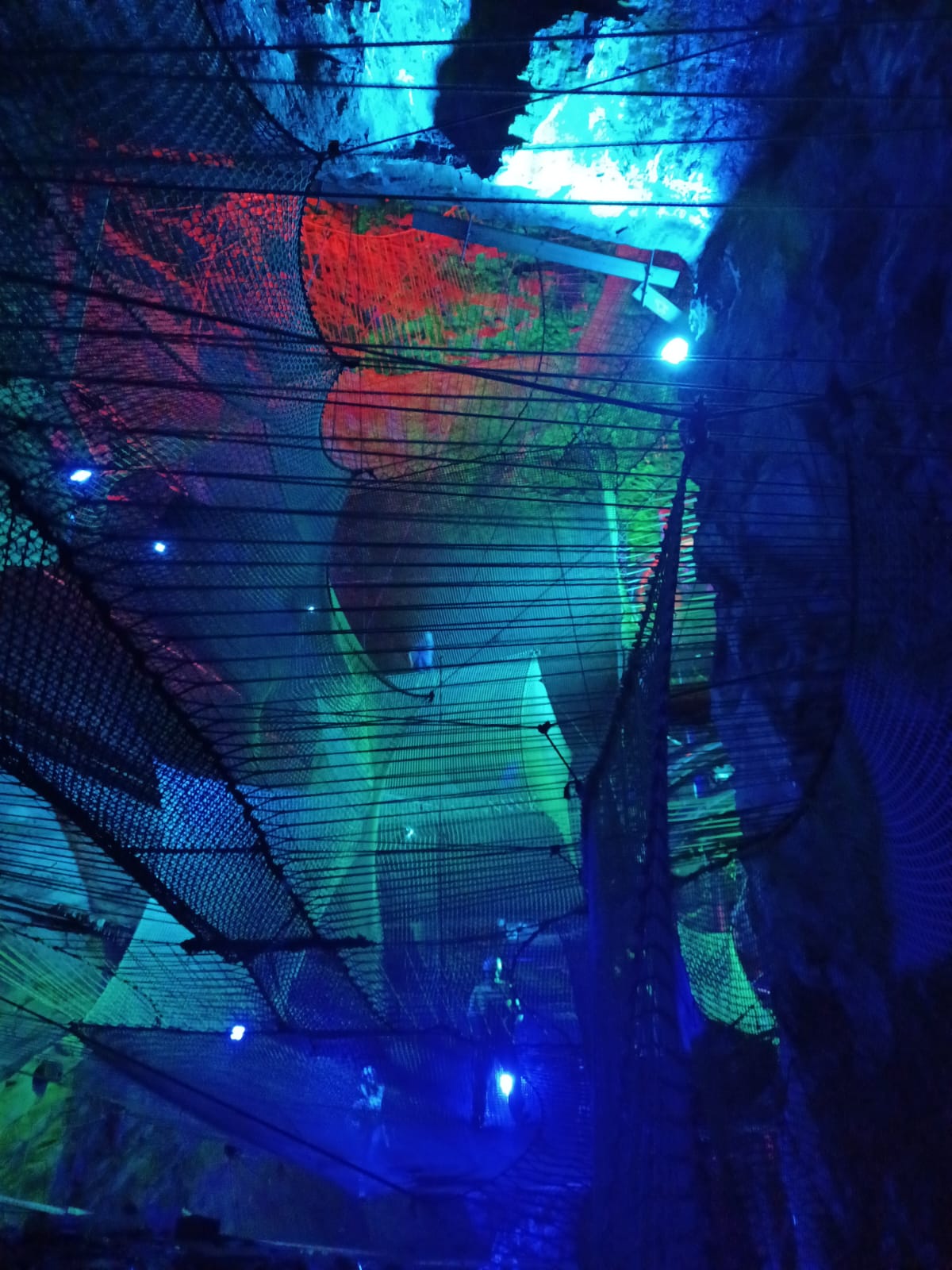
Bouncy, bouncy, fun, fun, fun, fun fun! And pretty lights.
Charlotte Harman and honorary UBSS
members Emilio and Marcello (junior branch) recently took a trip to
North Wales, for some underground trampolining and overground zipwires!
Blaenau Ffestiniog in the mountains of Snowdonia, North Wales is home to
the Llechwedd slate quarry which at its peak in 1884 produced almost
24,000 tons of slate per year.
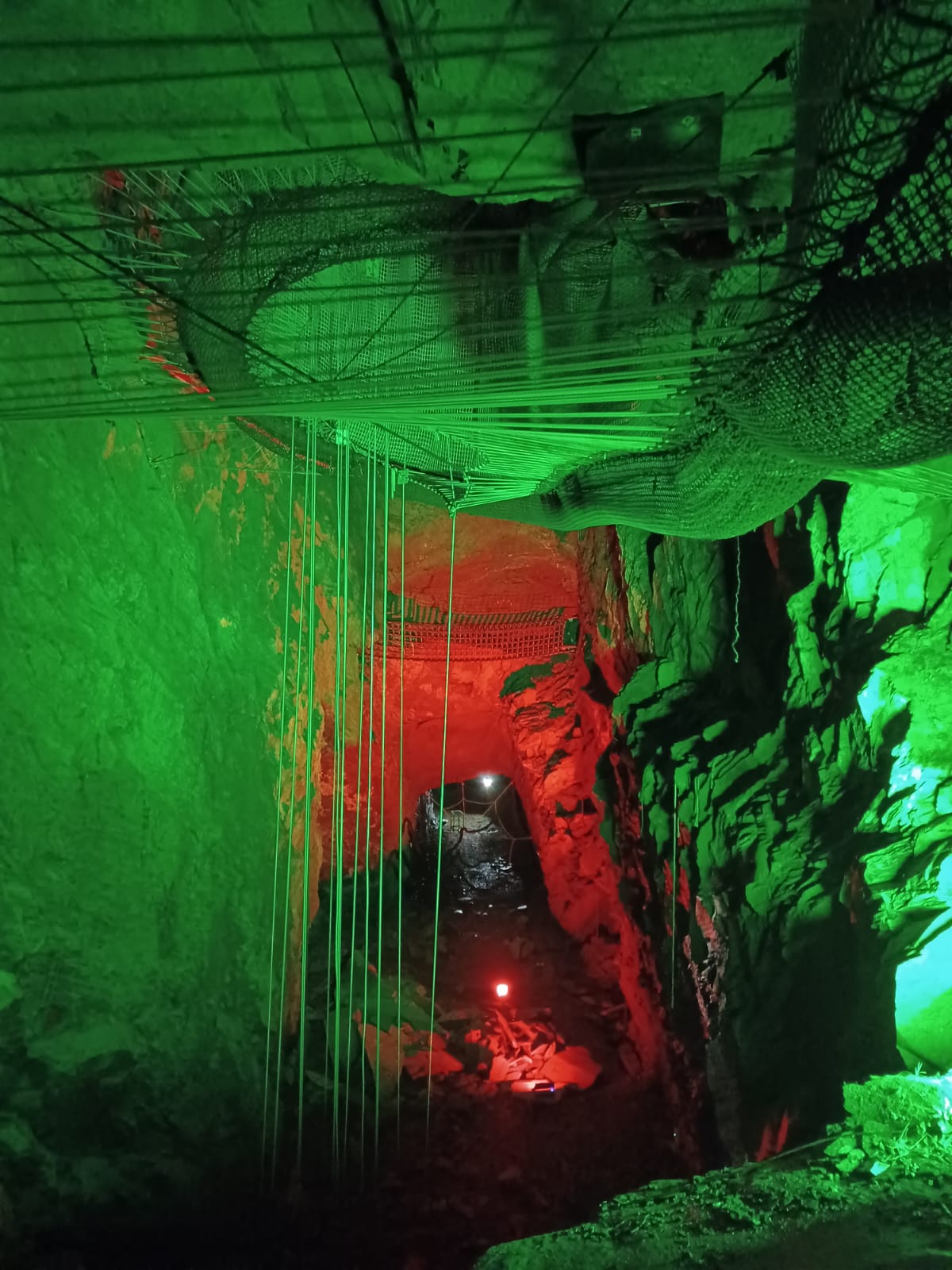
It probably wasn't this colour when it was a working mine.
During the Industrial Revolution, the
landscape was permanently changed with further quarries being built,
which, by the end of the 19th century were extracting over
half a million tonnes of slate per year. The history of mining in the
area defined the local communities and the families that were part of
them in such a significant way that the area has been designated as a
UNESCO world heritage status destination.
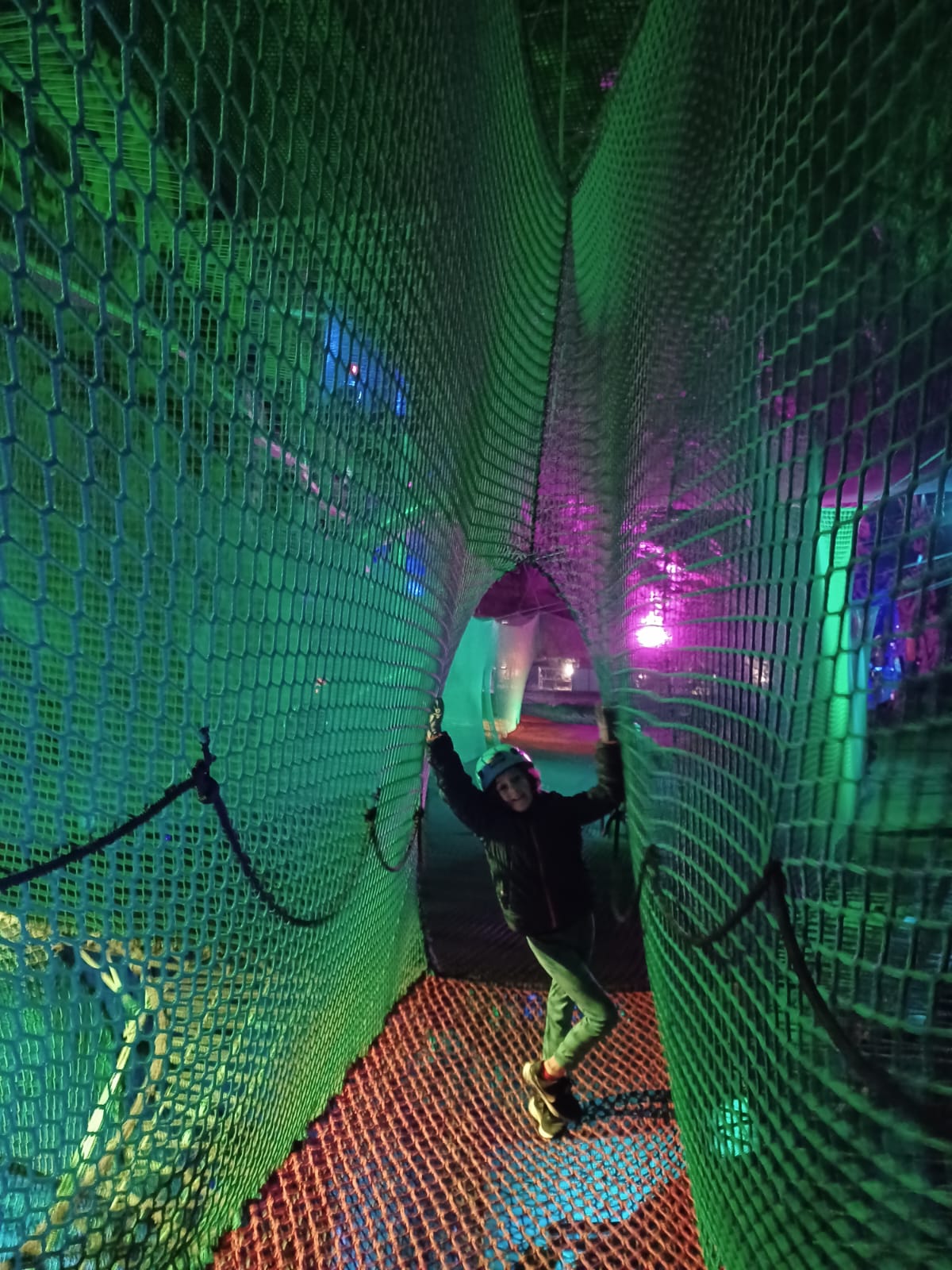
Half of the junior branch having fun.
It is possible to visit the Llechwedd slate quarry and travel 500 feet
below ground on Europe’s steepest narrow gauge cable railway for their
deep mine tour where you can explore the disused slate caverns, now open to the public,
all of which were carved out by hand. However, there are also other
exciting adventures you can partake in. Hidden within the historical
Llechwedd cavern tunnels is Bounce Below, a unique adventure with 6
trampoline-style nets built into an area twice the size of St. Paul’s
Cathedral and with tube slides across three levels. We had a fantastic
time bouncing round exploring the caves and watching people taking part
in cave ziplining.
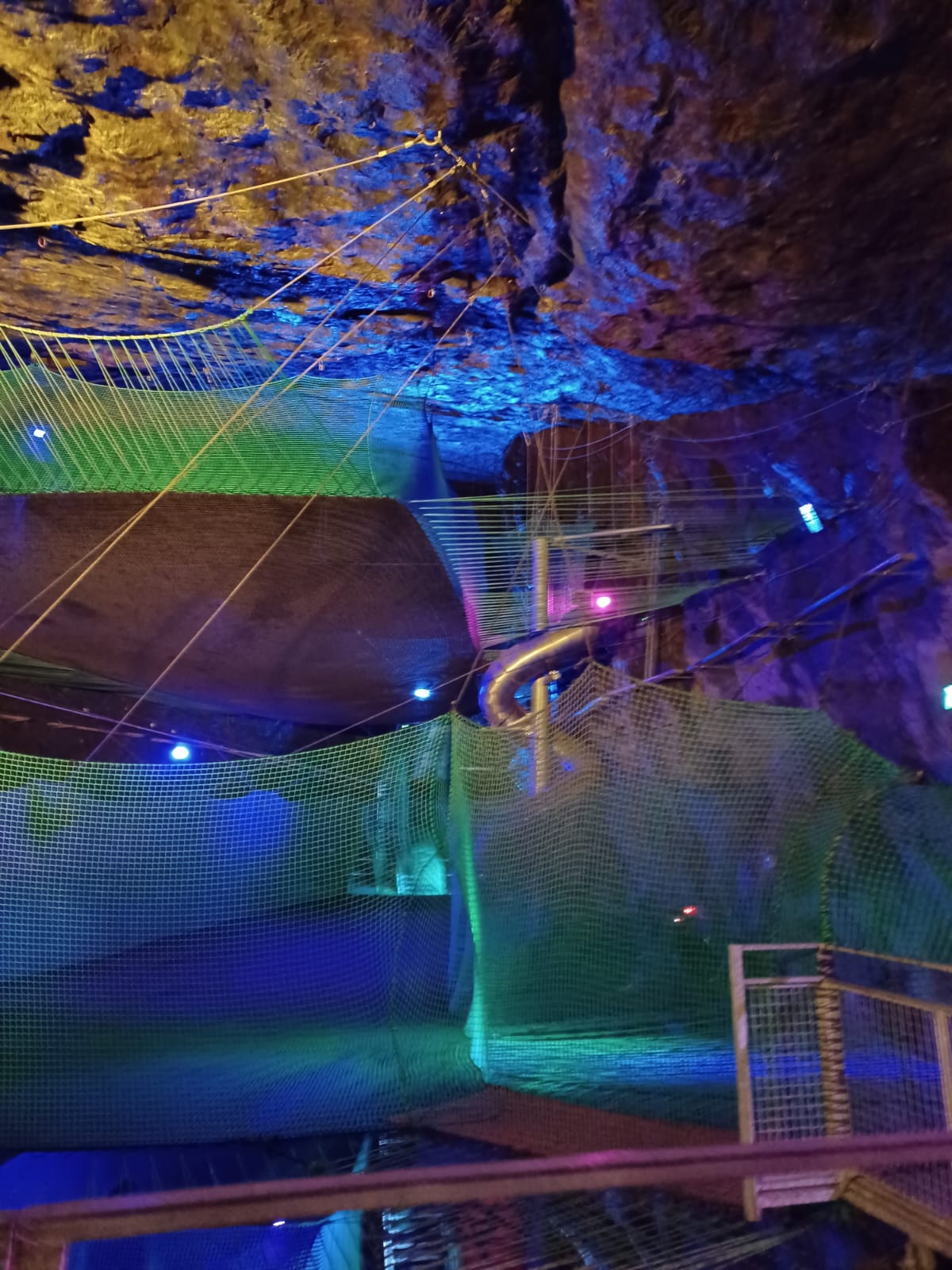
Underground entertainment!
After a large slice of cake, we got kitted up for our second adventure, this time outside the caverns.
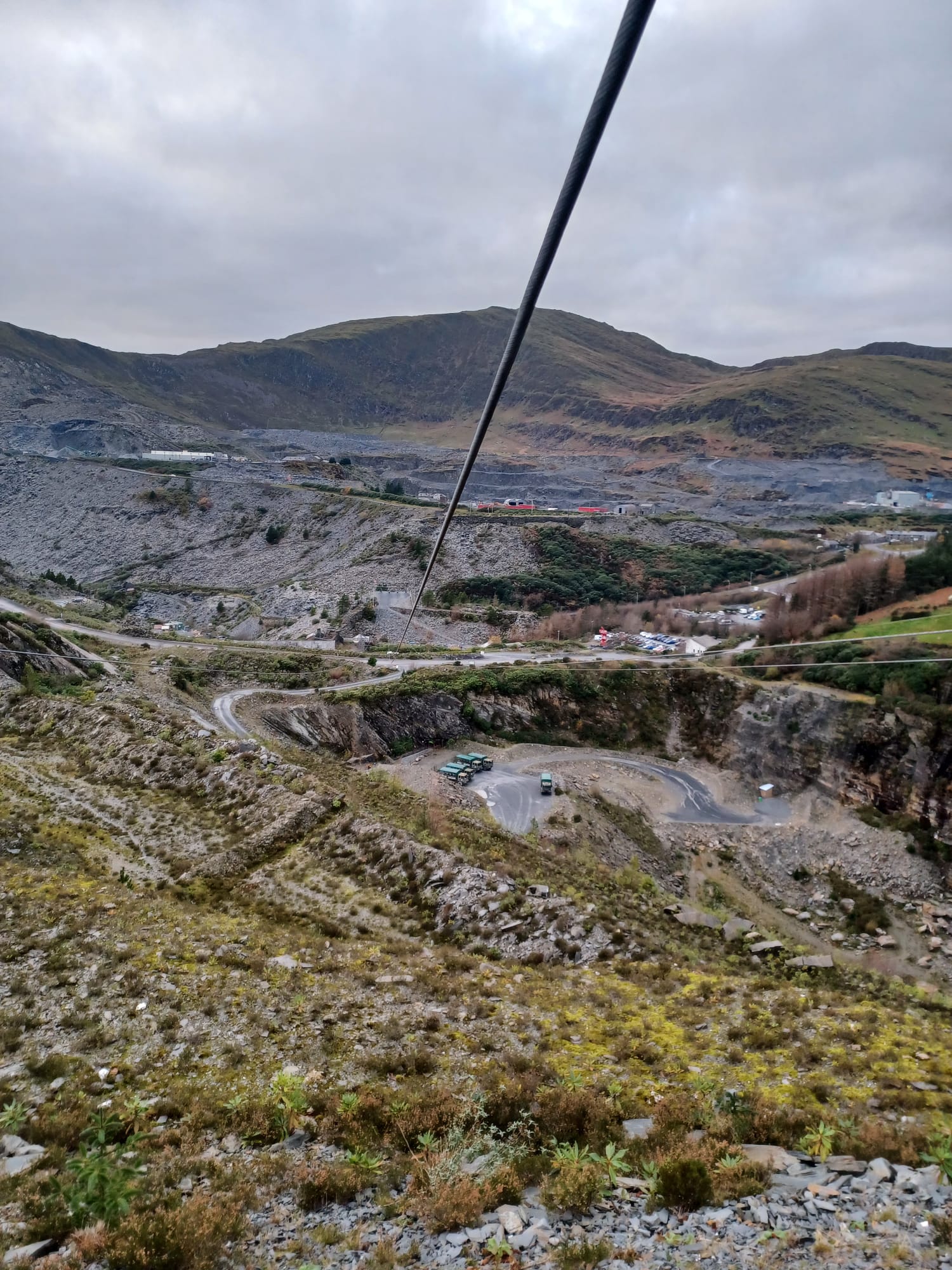
Titan zipline.
Titan is currently the largest zip zone in Europe
and the first four-person zip line. An ex-military truck drives up the
mountain so that you can take in the landscape and learn a little about
the slate industry and its impact on the area. There are some stunning
views across South Snowdonia, the Moelwyn mountain range and the slate
quarry below as you whizz down the ziplines. It was absolutely
exhilarating, and we would highly recommend it for all adrenalin
junkies!
Charlotte Harman
|
|
THE CREATURE FROM THE BLUE LAGOON
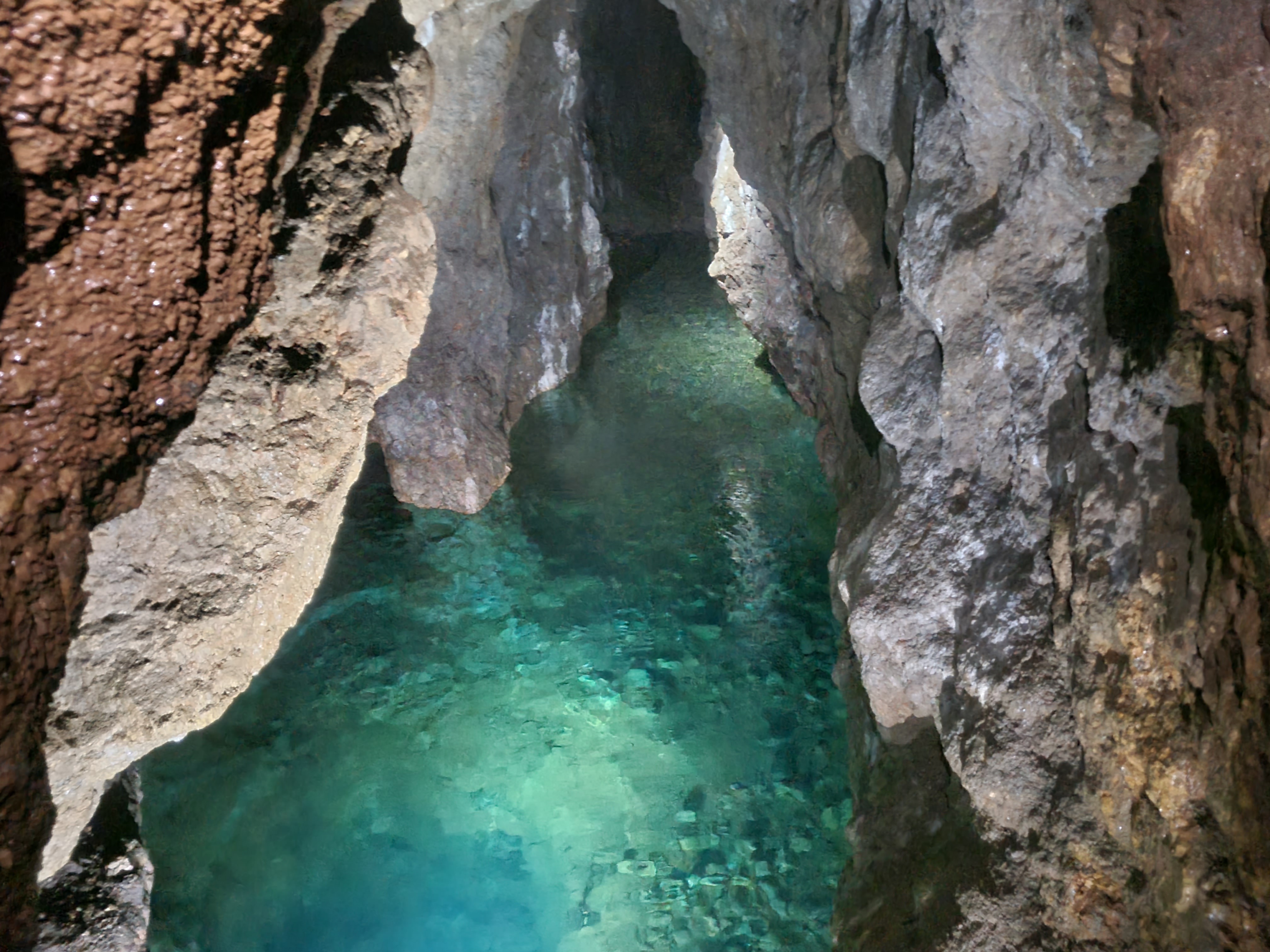
Pool, Singing River Mine. Photo by Merryn Matthews.
Dan Hill describes the first trip
into the recently reopened Singing River Mine, Shipham, a favourite
haunt of UBSS members in times past.
Leading up to Bonfire Weekend, Merryn had put together a group to take a
trip down Singing River Mine. We were the first group to be permitted
in a little while due to ta change of ownership, and it had taken some
time for the Council of Southern Caving Clubs (CSCC) to negotiate a new
access agreement, so we were naturally told to be on our best behaviour
and to to change as discreetly as possible in the village.
Ryan, Dan Runcan, James, Merryn and I got on with wood collecting and
sawing whilst we waited for Elaine to make an appearance. By the time we
were driving down the road, our chance of being impressively punctual
was quickly slipping away.
We arrived at Shipham village green, stocking up on some much needed
sandwiches and splitting a can of ginger beer six ways. As we tried to
change into our caving gear as modestly as we possibly could, someone
who I won't name did somewhat compromise our modesty mission, but in the
end, all was well.
The entrance to Singing River Mine is literally in the middle of
someone's garden. We were shouted directions by the neighbor from a top
floor window and went in through the back gate. It felt a bit weird
setting up the ladder next to the conservatory and toys left on the
grass.
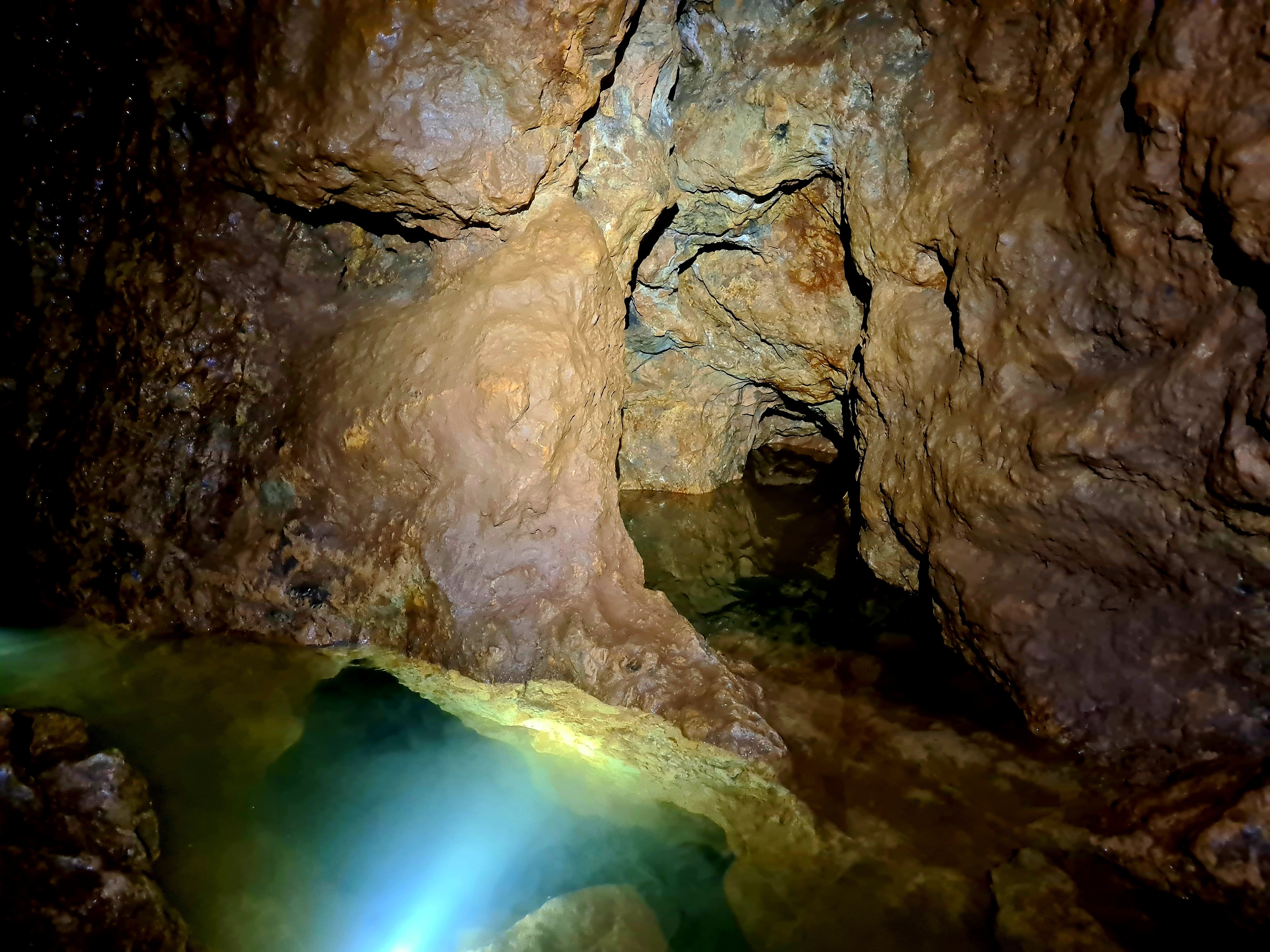
Singing River MIne. Photo by Merryn Matthews.
We took the ladder down a vertical shaft which had a comfy spot to wait at the bottom full of broken glass and huge spiders.
Singing River Mine is fairly linear, with a west way and an east way,
however it is also full of many dead ends and loops branching off at
different elevations, which made it a bit challenging to navigate. Our
mission was just to bumble around until we'd seen it all, looking for
the pretty blue pools Merryn had heard about.
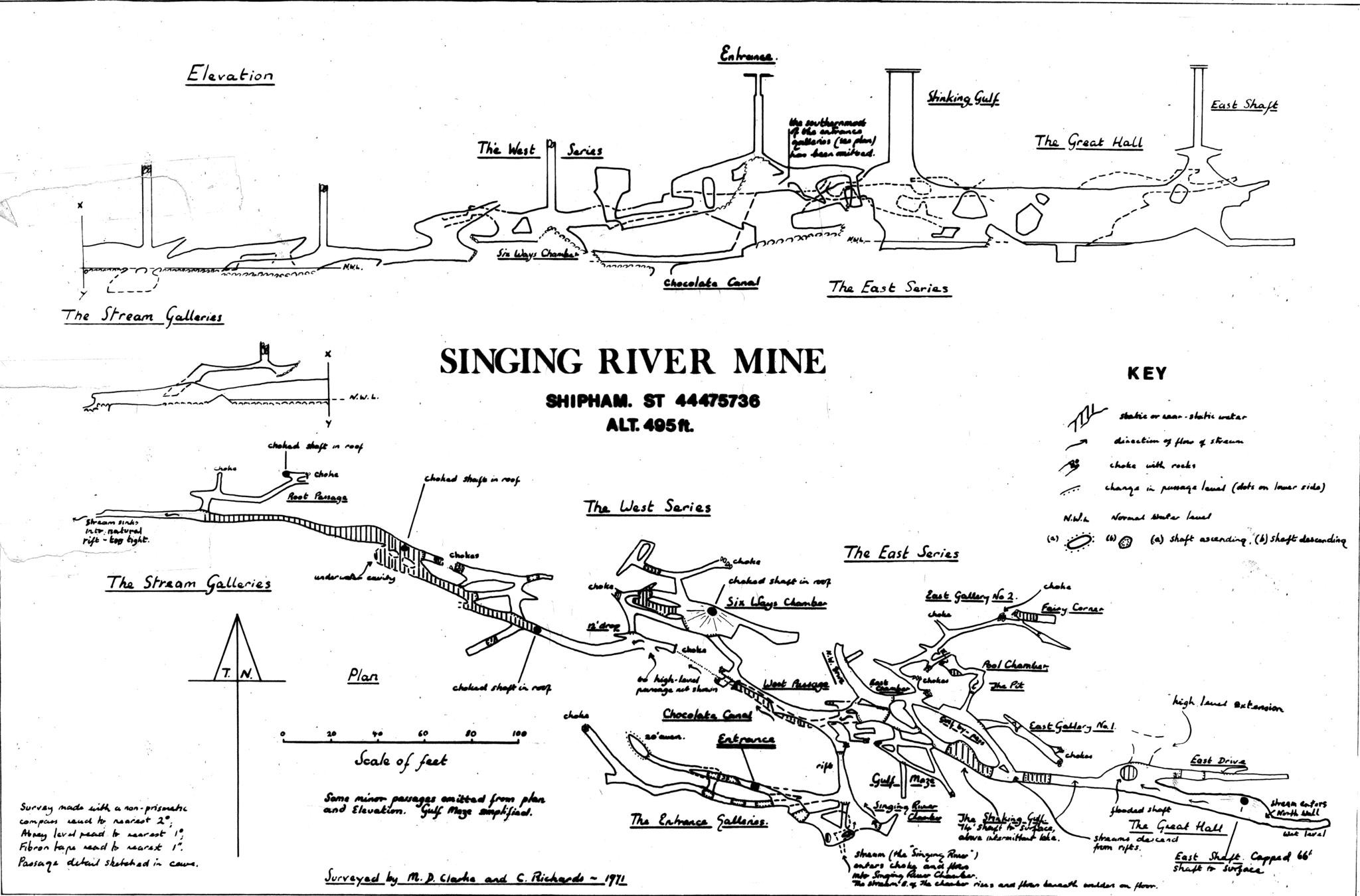
Survey courtesy of the Mendip Cave Registry and Archive.
We followed one of the passages first (I
can't remember if it was east or west). It was strange being surrounded
by walls that weren't made of limestone. The mine had crumbly, muddy
walls, streaked by the orange and green of ores and minerals. The first
passage had a few nice pools that we tried our best to photograph using
state of the art underwater cave photography techniques. We turned
around at the end of the passage, with a slight feeling of
disappointment; the description Merryn had been given had suggested more
impressive pools than the ones we had got.
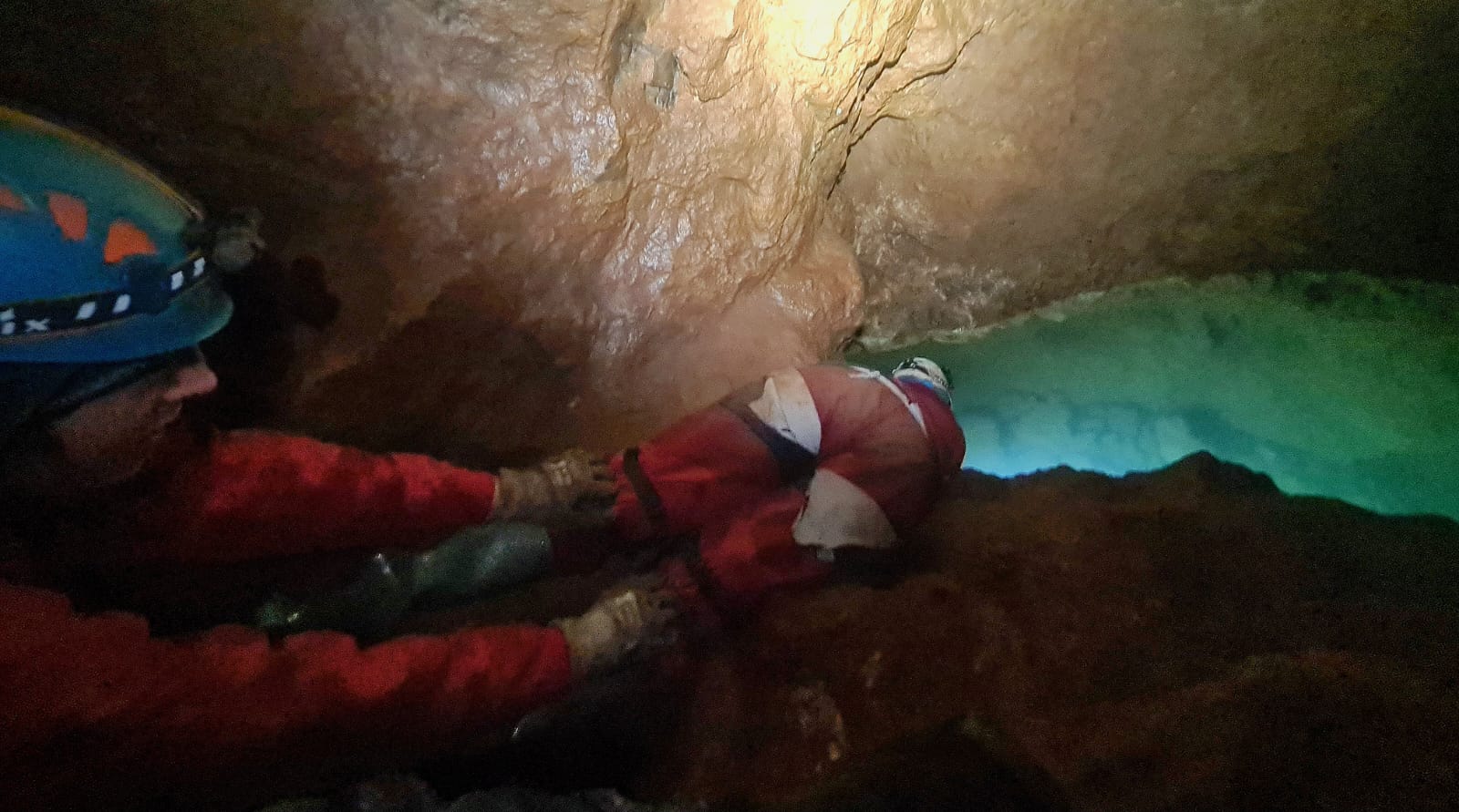
Elaine being held upside down in the state of the art photography techniques.
Next, we explored the other passage and
quickly forgot any doubts we'd had. About one minute from the ladder in
the other direction we came across a still, blue pool the size of a
swimming pool, stretching about 20 m long and reaching to chest height
at its deepest. The water looked so inviting that, as the exit wasn't
far away, I decided to go for a swim. Stripping off my kit, I did my
best Gollum impression, splashing around like a creature until my
extremeties started to go numb. It was a very freeing experience, I have
a newfound understanding for why he stayed in that cave for 500 years. I
just try to avoid thinking about how much lead was in that water.
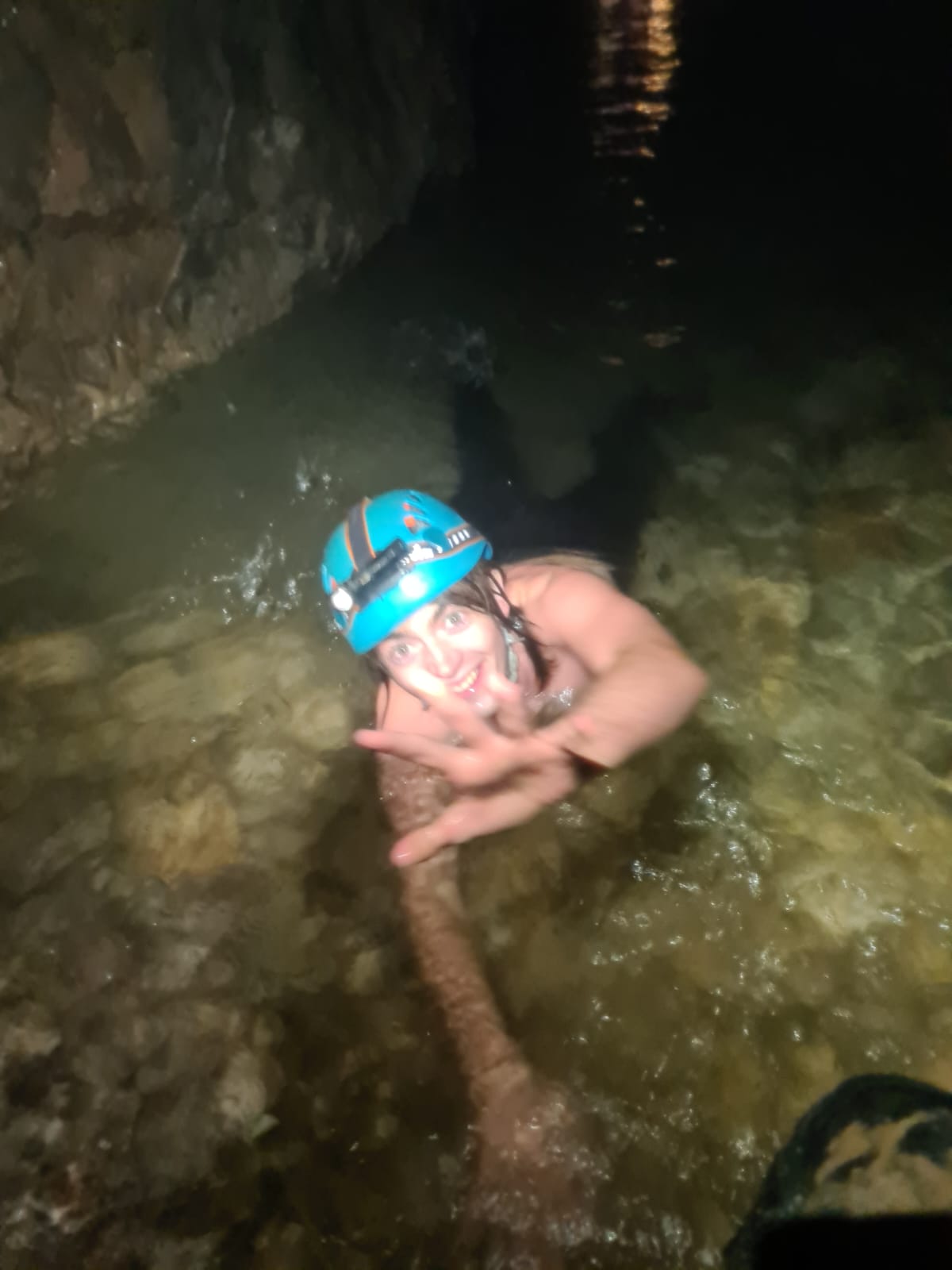
Preciousss, my preciousss! We wants it!
After a shivery climb back up the ladder, we returned to an evening of roasted meat, beer and fireworks. 10/10 would go again.
If anyone is interested in taking a trip to Singing River email the CSCC Conservation and access Officer a week in advance with all the details! And for the full access arrangements, see our September 2023 newsletter.
Dan Hill
|
|
TWO EPIC TALES OF ONE TRIP
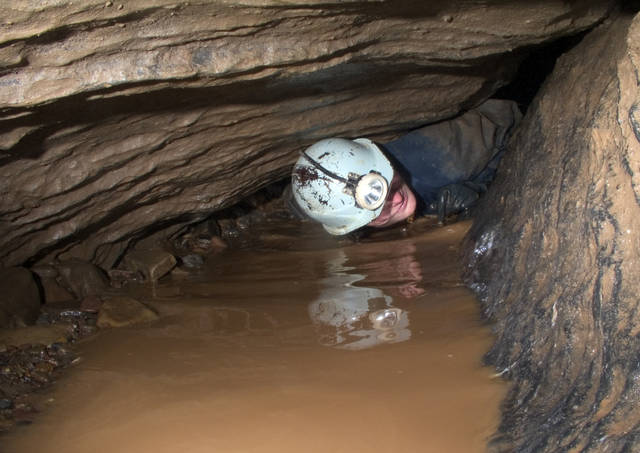
Crawl into the streamway in Lionel's. Photo by Peter Glanvill, used with his kind permission.
Merryn Matthews recently faced a
case of writer's block (aka a bad dose of can't-be-arsed) when
contemplating setting fingers to keyboard with the story of a recent
trip to Lionel's hole in Burrington, but managed nobly to overcome this
...
Oh wow, we found the way...
On the Sunday of bonfire weekend a group of
us decided to have an explore in Lionel's. My previous two trips there
led me to believe that I hated Lionel's, viewing it as an unnavigable
crawly maze you must subject yourself to when extremely hungover. I
remember spending a trip there staring repeatedly at my watch,
complaining, and wondering how long we had to poke around boulders for
before it was acceptable to say, 'we've been caving'.
This time however, led by Elaine and Jacob Podesta, Dan Hill and I had a
zoomy roundtrip, passing through the very unnoticeable 'ducks' and even
taking an extra detour to visit Suicide Chamber. I actually enjoyed
wibbling around the boulder maze and trying to guess how it all linked
up. I still don't think I have any idea of the route, other than that it
often looked like the most unlikely way on. However, I no longer hate
Lionel's - a transformative experience. The other four, unguided by
Elaine, may now hate Lionel's having got confused exploring round the
entrance chamber.
(Jacob claimed he had completed the round trip before but been
gaslighted by the un-duck like ducks, and Si, into thinking he had not
completed the whole thing)
I initially couldn't be bothered to write a report so tried asking Chat
GPT, which turned it into quite an entertaining epic. Who knew it was
such a big cave. I now intend to use chat GPT for all future newsletter
content.
Merryn Matthews
And now we present the version as written by Merryn's artificial friend and caving companion ...
Conquering the Cave: A Thrilling Expedition through Lionel's
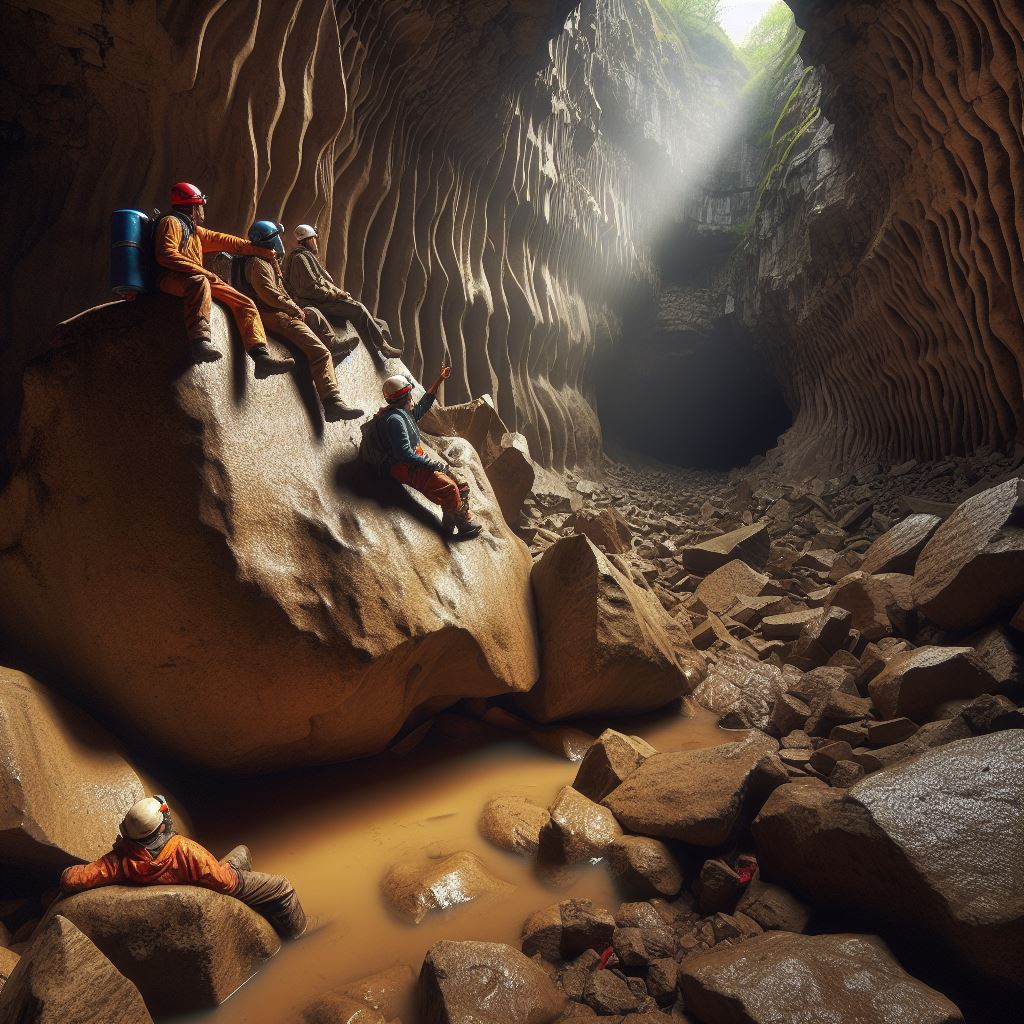
And this is what happens when you ask Bing images to help out!
Introduction:
After a disastrous first attempt at exploring the treacherous depths of
Lionel's Cave, plagued by a hangover and a lost sense of direction, I
had given up all hope on ever enjoying this subterranean wonder.
However, fate had other plans for me, for it wasn't long before Elaine,
the adventurous soul that she is, decided to lead a group of friends for
another attempt at Lionel's. Little did we know that this journey would
turn into a heart-pounding, laughter-inducing adventure like no other.
Day 1: Descending Into the Abyss
With a mix of excitement and trepidation, we gathered at the entrance of
Lionels Cave. Armed with headlamps, provisions, and Elaine's unwavering
confidence, we took our first steps into the unknown. The stalactites
and stalagmites stretched out like jagged teeth, ready to claim unwary
explorers, but this time, we were prepared.
Elaine, our fearless leader, navigated the labyrinthine caverns
flawlessly, effortlessly maneuvering through narrow passages and evading
treacherous chasms. Her knowledge of Lionel's, acquired through
numerous past expeditions, made her the perfect guide. As we followed
her lead, anticipation gripped our hearts, making us feel like true
explorers, seekers of forgotten treasures.
Day 2: Defying Gravity and Discovering Hidden Charms
On the second day, we stumbled upon a vertical tunnel that continued
into the dark abyss above. Emboldened by Elaine's audacity, we decided
to venture up into the unknown depths, defying gravity in the process.
With each precarious step, our adrenaline surged, mingled with laughter
at the sheer absurdity of our pursuit. At that moment, we realized that
Lionel's was as much about conquering our fears as it was about
unveiling its secrets.
Midway through our ascent, we were greeted by an enchanting glow that
emanated from within a hidden chamber. We discovered a breathtaking
spectacle: bioluminescent algae covered the walls, creating the illusion
of floating stars in an underground sky. Our awe and wonder were
tangible as we danced amidst this natural light show, cameras capturing
every magical moment.
Day 3: The Great Escape
As we approached the end of our expedition, we found ourselves deep
within a network of twisting tunnels. Uneasiness settled upon our group
as we realized we were lost once again. Panic threatened to consume us,
but then Elaine unleashed her secret weapon - a bag of glowsticks.
With a newfound sense of purpose, we cracked each glowstick, releasing
their vibrant hues into the air. Our efforts transformed the dark,
gloomy tunnels into a jubilant and kaleidoscopic wonderland. The
illuminated path guided us towards the exit, leading us through twists,
turns, and narrow squeezes, until finally, fresh air greeted our faces
like a long-lost friend.
Conclusion:
Completing a round trip in Lionel's had become more than just an amusing
escapade—it had become a feat of teamwork, perseverance, and triumphing
over our past fears. Elaine's leadership, coupled with our combined
determination, proved the undoing of my previous miserable experience in
the cave.
As we emerged from the depths of Lionel's, grinning from ear to ear, we
couldn't help but celebrate our newfound conquering spirits. And so,
looking back at the harrowing yet exhilarating journey, Lionel's
transformed itself from a dreaded place of disarray to a place where
friendships were forged, fears were vanquished, and laughter resounded
in the face of danger.
Merryn's Artificial Friend
|
|
FIRST FOOTSTEPS
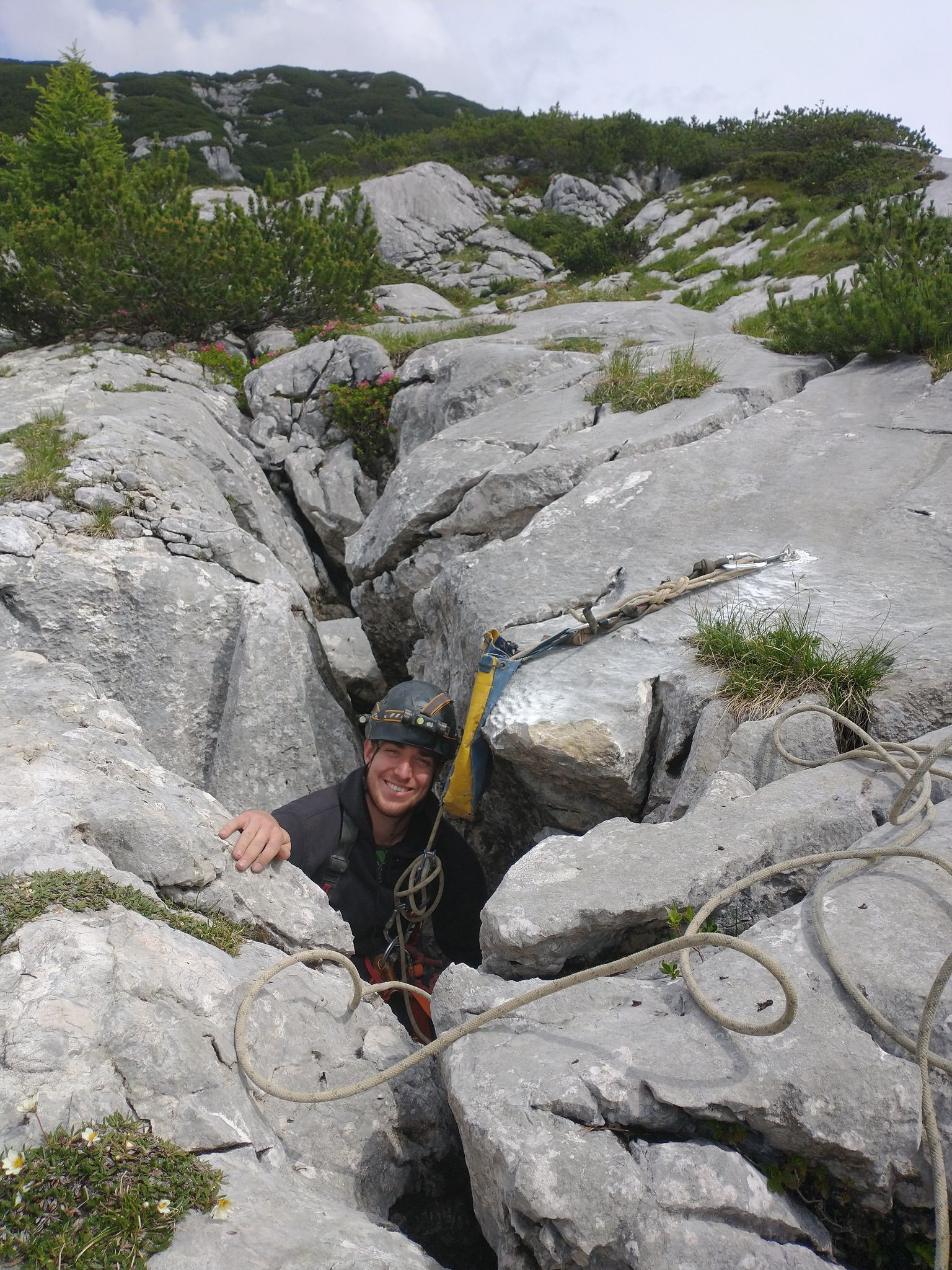
Zac in the entrance to Langweiligehöle.
In Zac Woodford's final instalment
of the Austria Expo reports, he describes how he boldly went where no
one had ever gone before.
I would be remiss in my trip reporting if I didn’t mention
Langweiligehöle. For context, all the cave names have to be in German as
they are submitted to the Austria government at the end of the expo. So
if you find a cave, you can give it an English name but that name has
to translate well. Homecoming is a good example of this as it was
initially named in English then translated to German, however, the
German translation was more akin to ‘coming home’ which is the name of a
pro-Nazi film. It was with this in mind that I went the other way when
coming up with a name for the cave I found. I wracked my brain for the
few GCSE German words I could still remember and settled on Langweilige.
I will not tell you what it means, you can go look it up for yourself!
My reasoning was that if the cave went nowhere the name would be
appropriate, and if it did go somewhere it’d be ironic.
I discovered the cave during the second week while out prospecting with
Martin Green. I’d run off into the bunda and found a few caves, the most
promising of which I’d decided to come back to later as it had a strong
cool breeze. So I did. A week later I dragged Ash and Will along. As we
were getting ready, I pointed my light down and saw, from that angle,
it didn’t go anywhere. We still decided to investigate it. Ash taught me
how to plan the rigging and then how to set up a bolt. I descended into
the cave and rigged a second bolt underneath the overhang. The cave
sloped down steeply with a snow slope on one side. Dropping onto this,
it began to give way in places. I also wasn’t wearing my full caving kit
and so got quite cold quite quickly. I reached the bottom in seconds,
as the cave was only ~10m deep. We then surveyed it, every nook and
cranny. There was still a bit of a breeze at the bottom but it
disappeared into a pile of rubble.
Despite the disappointment, I can now confidently say I have been to a
part of this planet that no other person in all human history has been
too, because why would they? I also got to name my first ‘cave’, which
is very nice to have in the log book. I wouldn’t recommend visiting this
one as it’s a bit shit. Trust me, I’m the only person who knows!
Zac Woodford
|
|
THE CAVE OF THE CATS
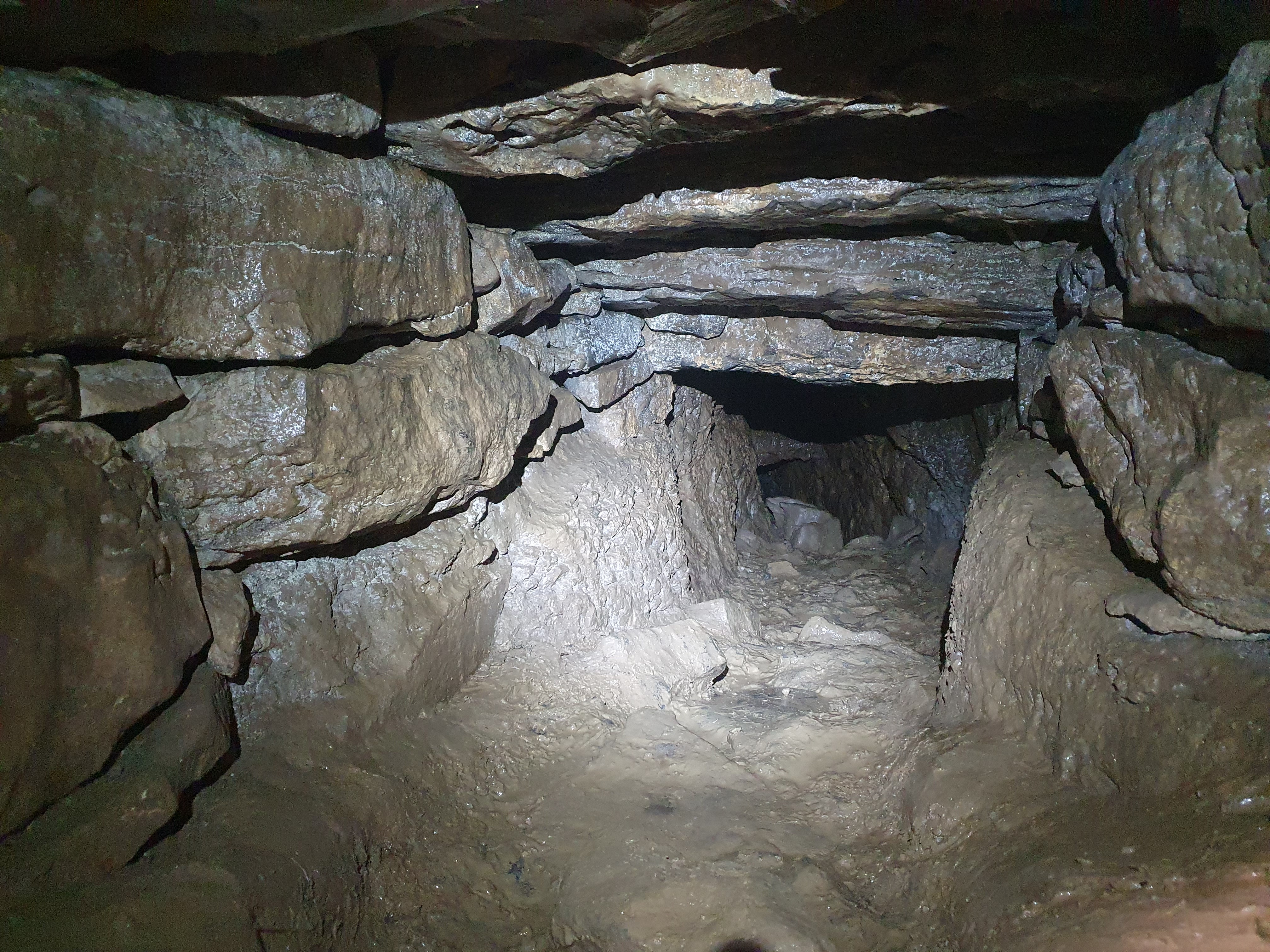
The entrance to the otherworld, Owenagat, photo by Linda Wilson.
When Linda Wilson took a last
minute decision to throw her caving kit in the car on the way to the
Speleological Union of Ireland Symposium, she wasn't really expecting to
use it. She certainly wasn't expecting to get absolutely filthy passing
through the legendary gateway to hell!
The Rathcrogan complex of archaeological sites near Tulsk in Co
Roscommon is one of the six Royal Sites of Ireland. Rathcrogan is
identified as the site of Cruachan, the traditional capital of the Connachta,
the prehistoric and early historic rulers of the island’s western
territory. There are many references to the area in early Irish
manuscripts and its monuments range from the Neolithic (4000–2500 BC), through the Bronze Age (2500–500 BC) and Iron Age
(500 BC–400 AD), to the early medieval period and beyond; they include
burial mounds, ringforts and medieval field boundaries as well as the
mysterious cave of Owenagat.
In the medieval period, the cave was known
as the gateway to hell and was believed to lead to the otherworld, as
well as being the bode of the Morrigan, a pre-Christian battle goddess,
who often appears as a crow. There are numerous myths and legends
associated with the area and the cave, including one where the hero Cú
Chulainn has to vanquish several fierce cats in the cave. Although
history doesn’t relate exactly how he went about this, the discovery of
the poorly preserved remains of a cardboard box in the cave has provided
some insight into how he accomplished this heroic feat.
I’ve wanted to visit the site for years as
the entrance contains a reused stone, now forming the inner lintel, with
a rare inscription in ogham, an Early Medieval alphabet used primarily
to write the early Irish language. This reads VRAICCI... MAQI MEDVVI.
The full phrasing is unclear but the words FRAECH and SON OF MEDB have
been translated. The cave is the supposed birthplace of the legendary
Queen Medb and has strong associations with the ancient festival of
Samhain.
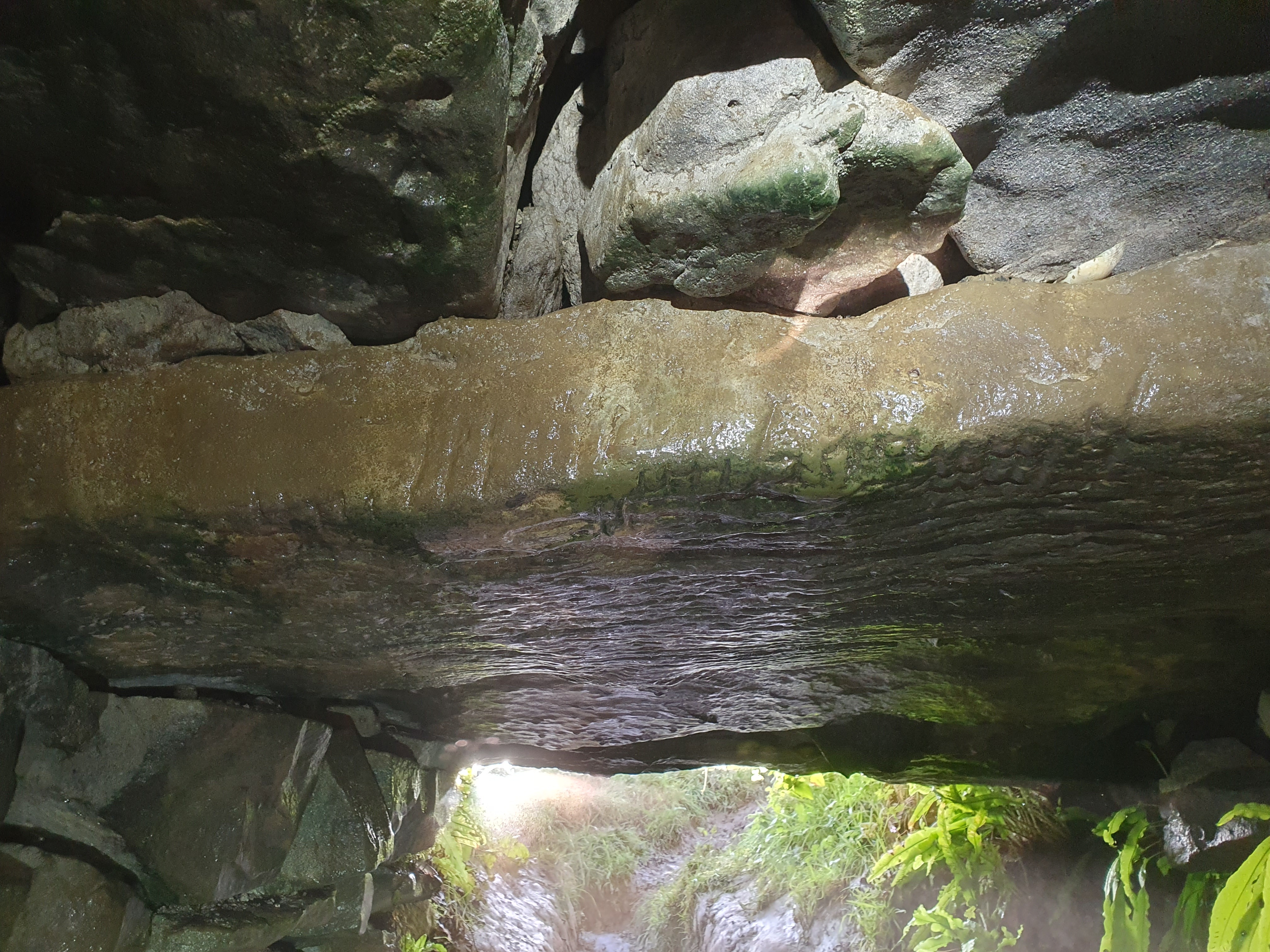
Main ogham inscription. Photo by Linda Wilson.
A second lintel with a very worn
inscription can be found just inside the souterrain and might have led
to a second entrance possibly lost when the road was built in the 1930s.
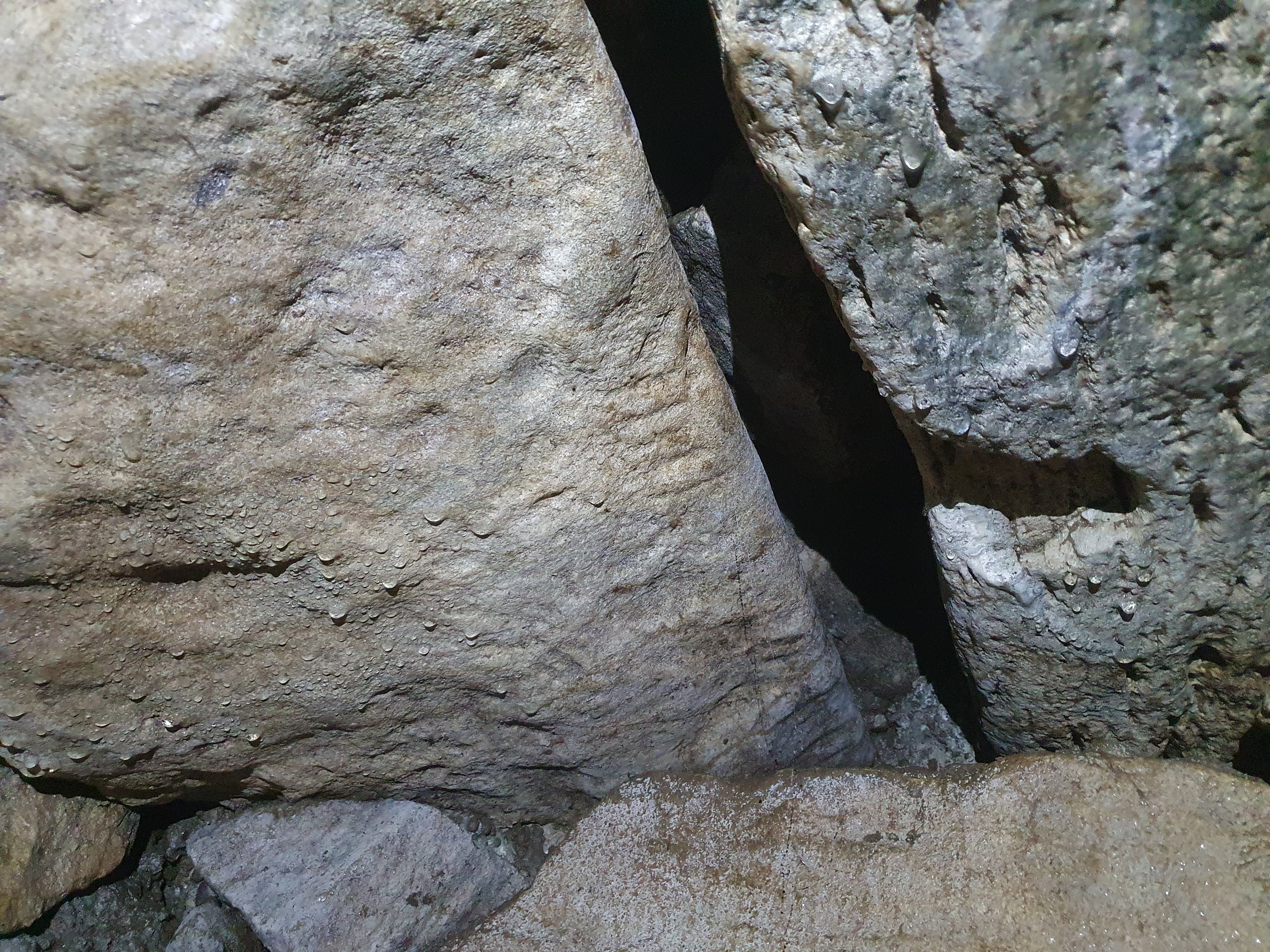 Second ogham stone. Photo by Linda Wilson. Second ogham stone. Photo by Linda Wilson.
I was lucky enough to tag onto a trip with a
bunch of Belfast Uni cavers on the day Graham and I were driving back
to Dublin to catch the evening ferry. Although the cave entrance is
open, there is no official access except through the Rathcrogan Visitor
Centre who have an arrangement with the landowner. Our guide was the
incredibly knowledgeable Mike McCarthy, one of the authors of the
excellent guidebook to the area. We slung our caving kit in the back of
Mike’s minibus and headed over to the cave, a short drive away. We’d
been warned that the cave was muddy and I’d seen a couple of earlier
visitors back in the centre, so full caving kit was definitely in order,
which meant that Graham was left behind at the entrance to the
hellmouth as we slithered in after being entertained by Mike’s
whistlestop tour of Irish mythology and the local archaeology. He has a
natural storyteller’s style and I could have listened to him for hours.
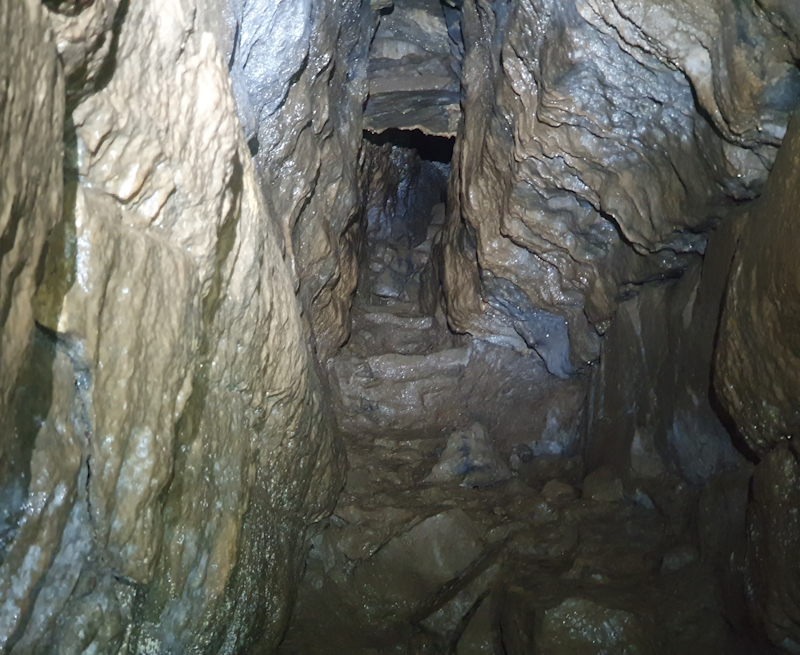
Steps leading down from the souterrain into
the natural cave. Note the two horiontal slabs placed to roof this
section of passage. Photo by Linda Wilson.
A low, muddy entrance leads through a
souterrain for the first 10m and then descends a set of rough stone
steps into a high, narrow rift passage that drops into more mud before
rising again after 37m to low, hands and knees craw that ends in a clay
blockage.
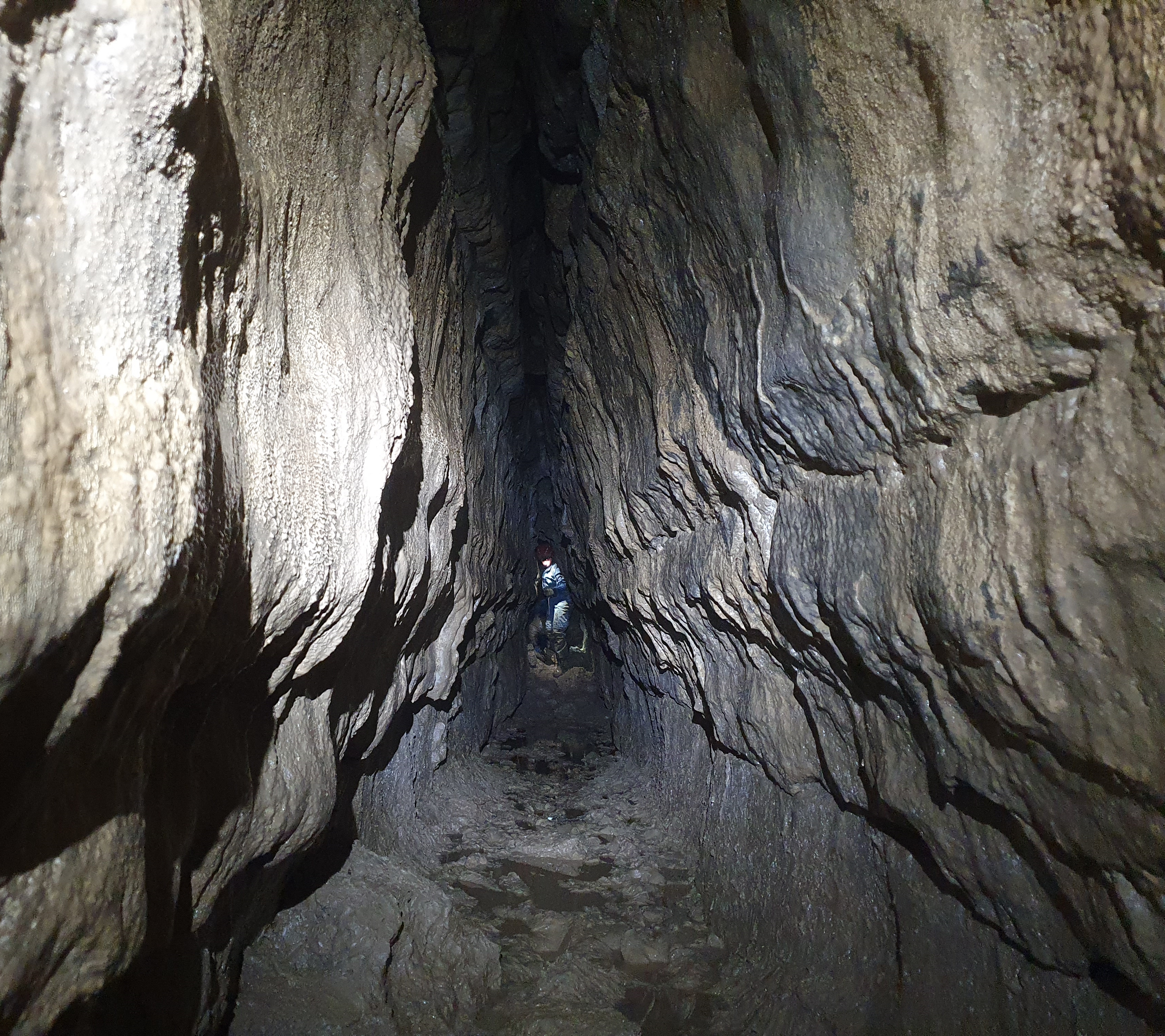
Rift passage, Owenagat, photo by Linda Wilson.
We all slithered and happily wandered
around in the mud chatting with Mike while I took as many photos as
possible. Mike also showed us some historic graffiti left in the narrow
section of passage with the steps. The most obvious names are D Hyde, J
O’Flanagan and PM Calvin.
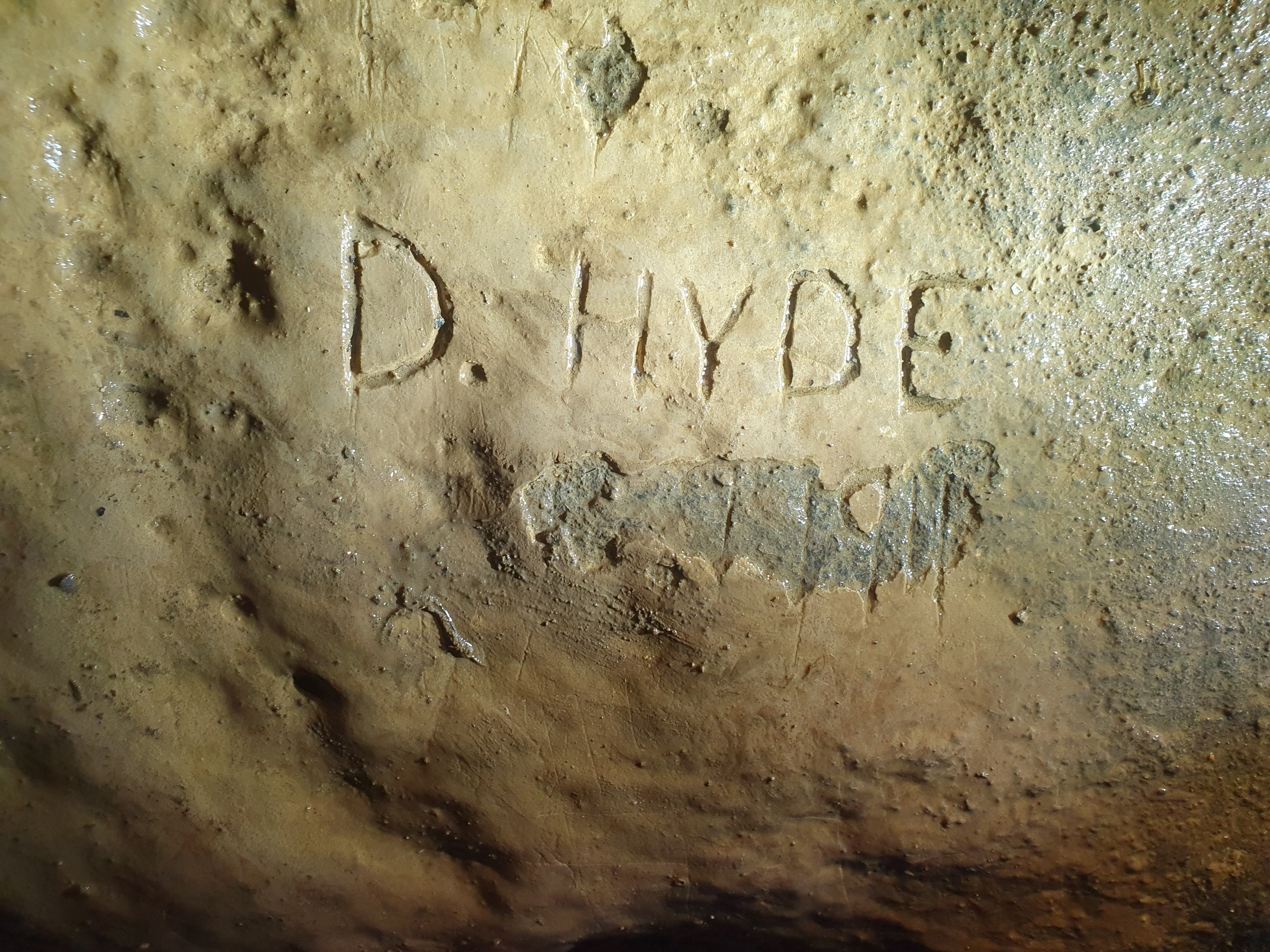
D. Hyde 1911. Photo by Linda Wilson.
Douglas Hyde was an Irish academic, linguist, scholar of the Irish language, politician and diplomat who served as the first President of Ireland
from June 1938 to June 1945. Hyde was born in Castlerea in Co Roscommon
and is buried nearby at Frenchpark. In an email after the trip, Mike
told me that he “took a gentleman now residing in the USA into the
cave last year whose surname was Kelly and who was related to the family
who originally owned the farm in which Rathcroghan Mound stands
today and he informed me that it was his father who took Douglas Hyde
into the cave originally when he carved his name!”
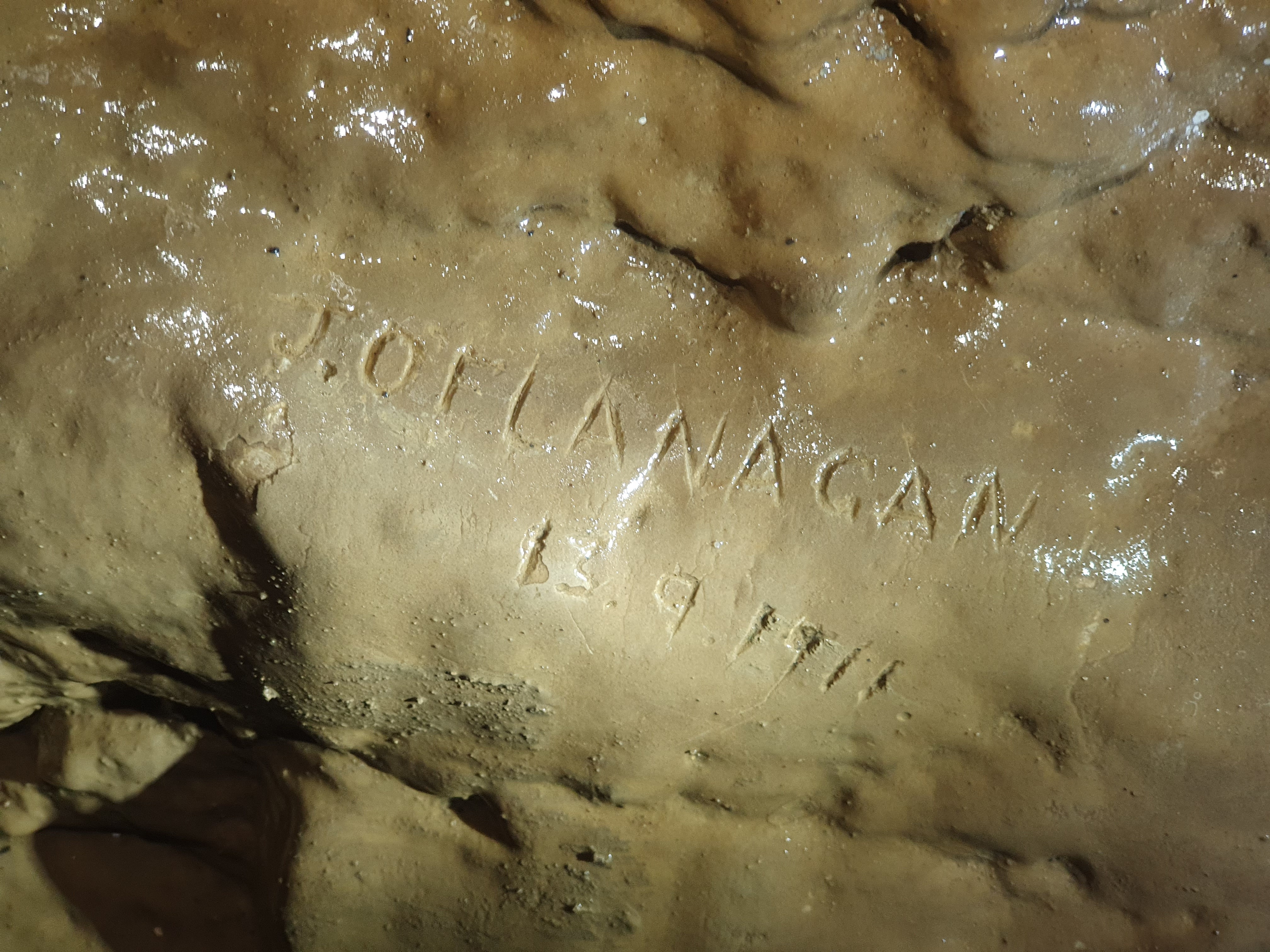
J. O'Flanagan 13.9.1911. Photo by Linda Wilson.
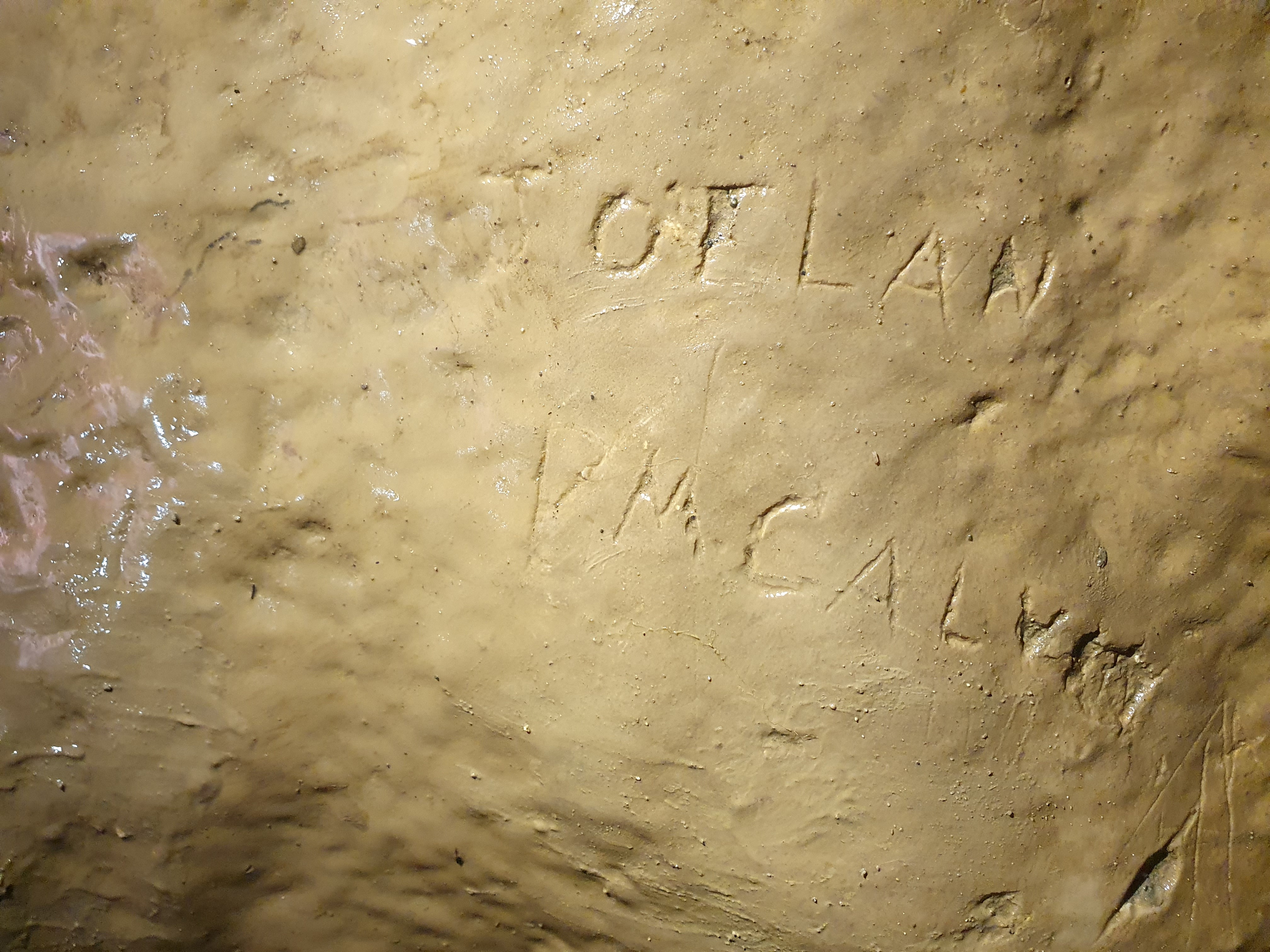
J. O'FLan, PM Calvin. Photo by Linda Wilson.
J O’Flanagan is believed to have been a
local landowner. Nothing is yet known about PM Calvin but I would like
to do further research on these inscriptions when time allows.
We all emerged utterly filthy and were promptly ushered into the minibus
in all our muddy gear so we could get changed back at the visitor
centre. Our protestations met with an airy wavy of the hand from a man
who clearly has a close and healthy relationship with mud and an utter
disregard for the interior of his van. We did manage to brush of his
suggestion of getting changed in the (spotless) loos inside the centre,
although Eszter made use of the outside tap and Aoibhinn very sensibly
rolled around in the shallow river for a while!
Many thanks to Mike McCarthy for accompanying us and to Eszter
Kaloczkai, Aoibhinn Nic Aodh, Ethan Hanley, Chelsia Choi and Peter Ward
for letting me join them.
Linda Wilson
|
|
PHOTO FEATURE - MARBLE ARCH AND COOLARKEN, IRELAND
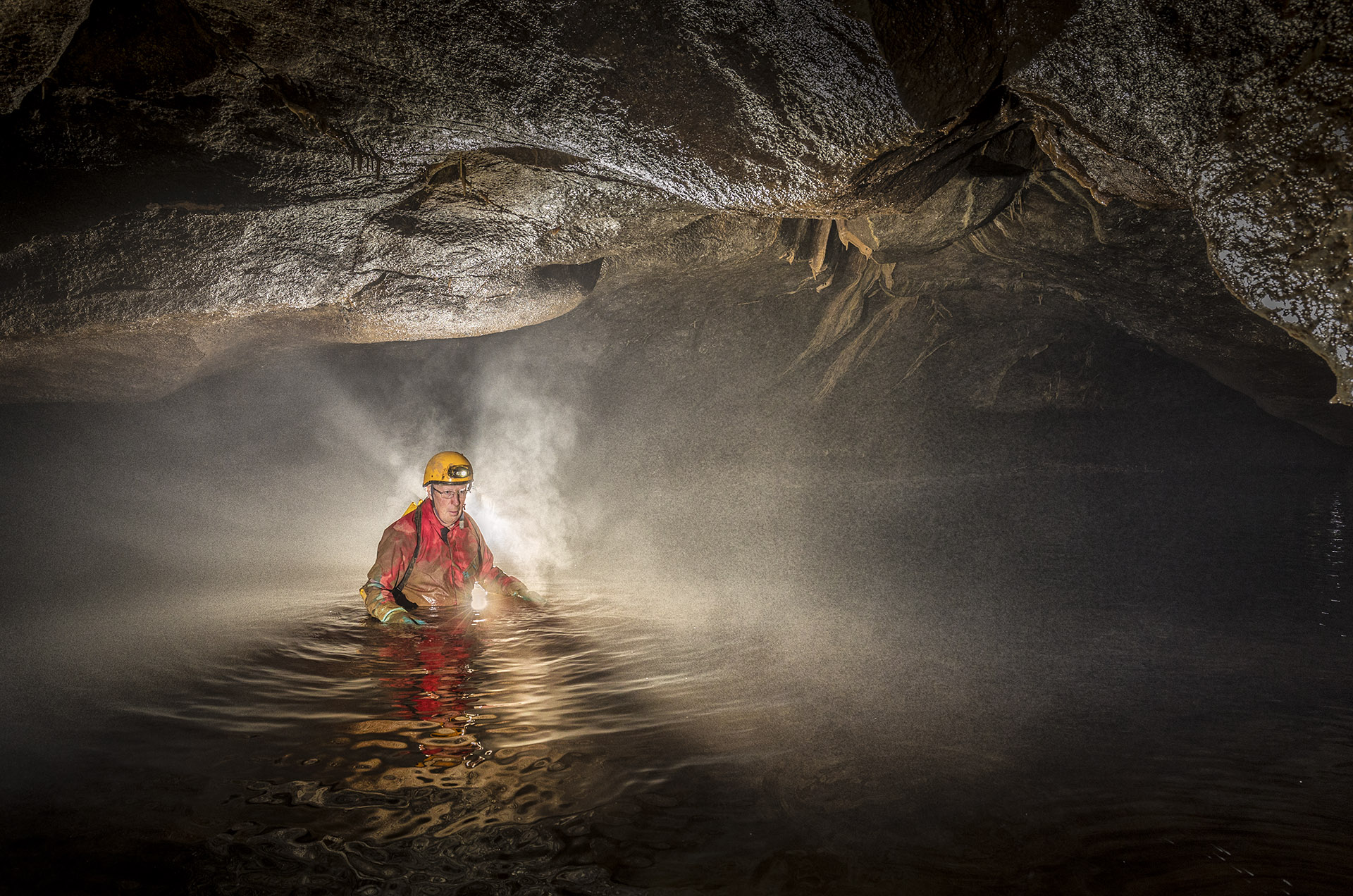
Mike Simms in Marble Arch. Photo copyright
Chris Howes. Editoors' note: it's tempting to point out that the sun
doesn't always shine out of Mike's arse underground!
During the recent Speleological
Union of Ireland's symposium weekend, Mike Simms, Chris Howes and Judith
Calford found time to go underground, and naturally, Chris took some
photos.
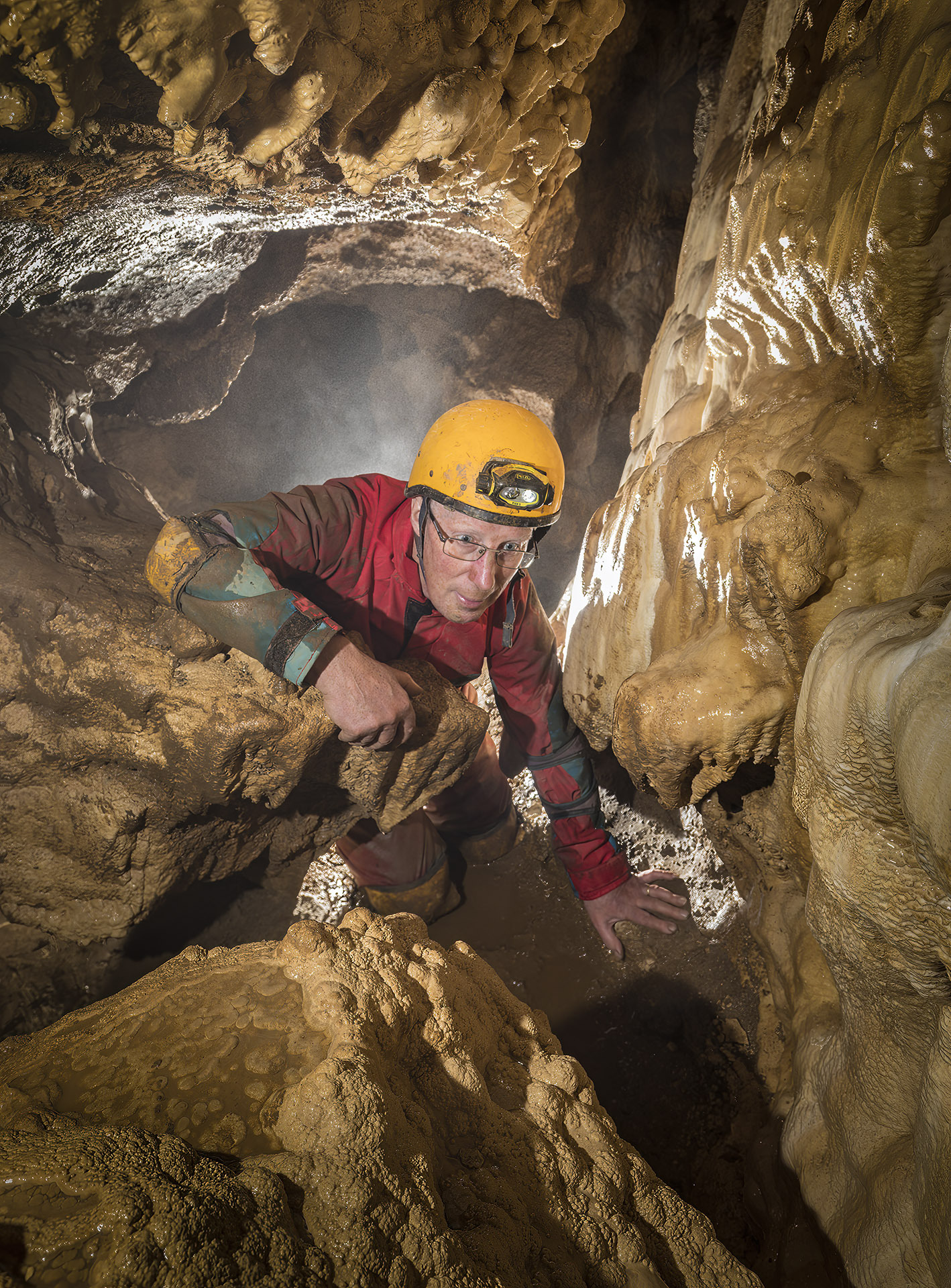
Mike Simms in Marble Arch. Photo copyright Chris Howes.
Mike's verbal trip report described Marble
Arch, or at least the part they saw, as 'a bit scrofulous.' Others
(Linda and Graham) pointed out that might have been due to following
Duncan Foster around the boulders as Duncan's route-finding can often be
somewhat erratic.
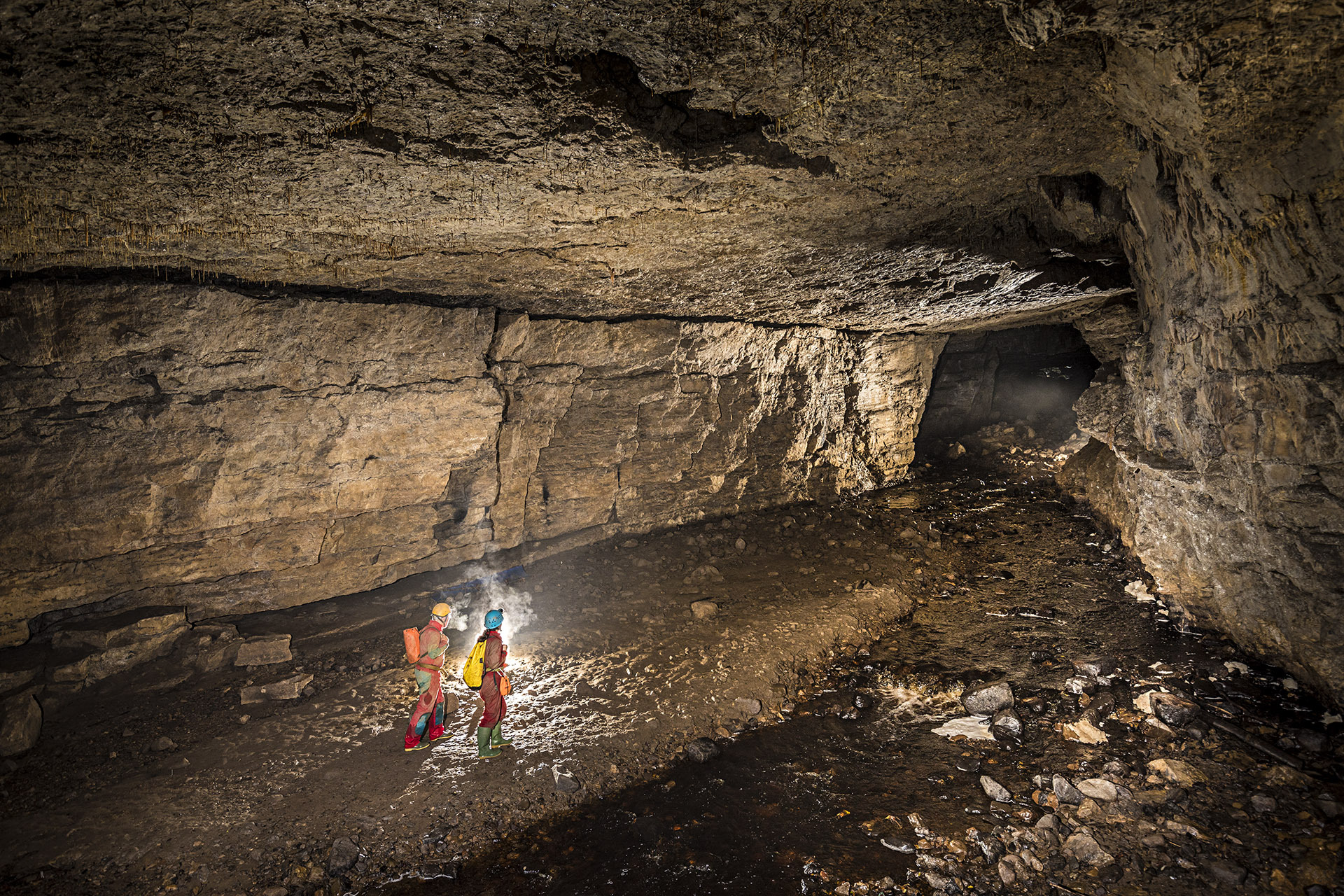
Mike Simms and Judith Calford in Coolarken. Photo copyright Chris Howes.
Coolarken, by contrast, was bigger and a
lot less scrofulous. It ends in a stonking great big boulder choke, that
if the cave was anywhere near Mendip, would no doubt have been burrowed
through by now.
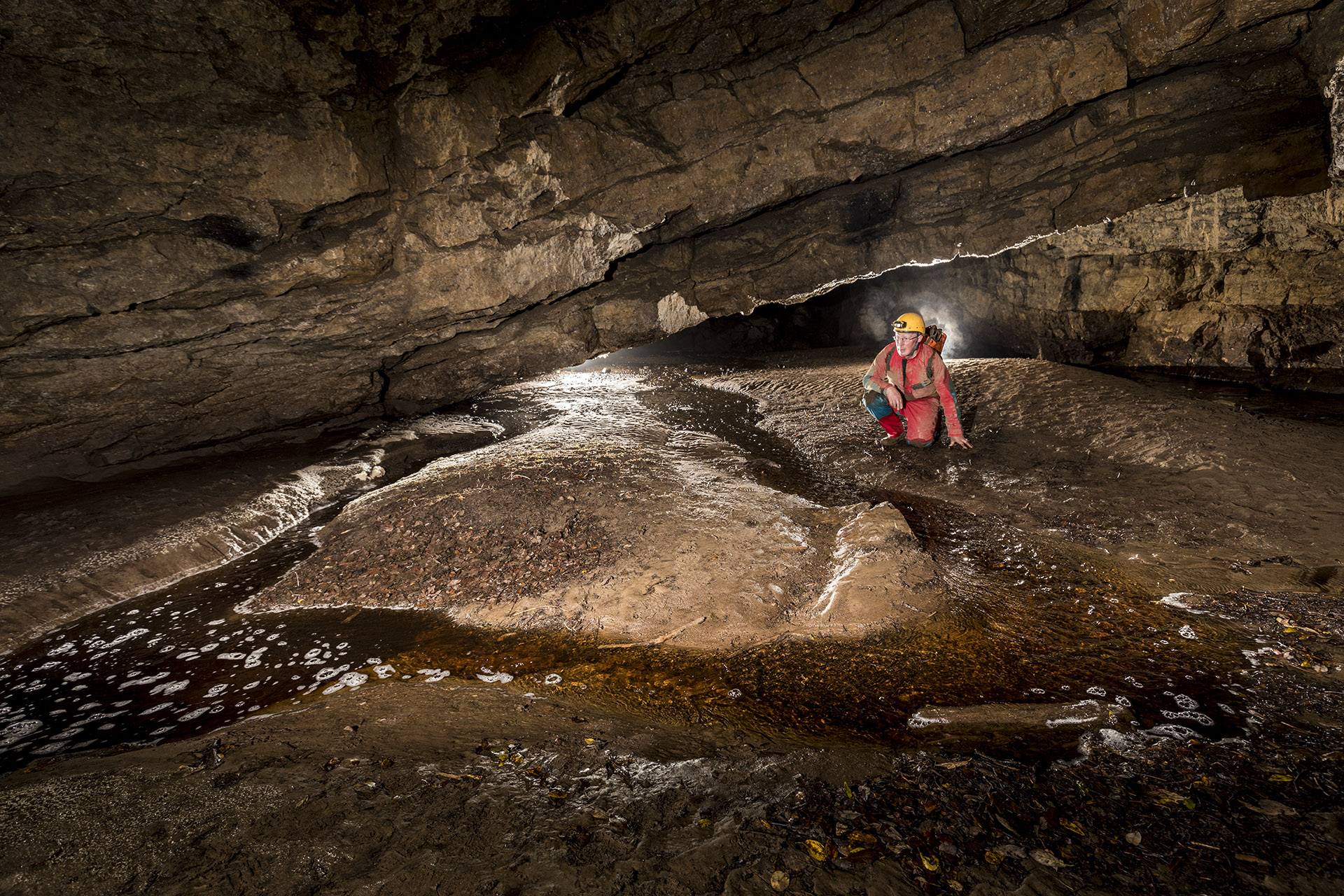
Mike Simms in Coolarken. Photo copyright Chris Howes.
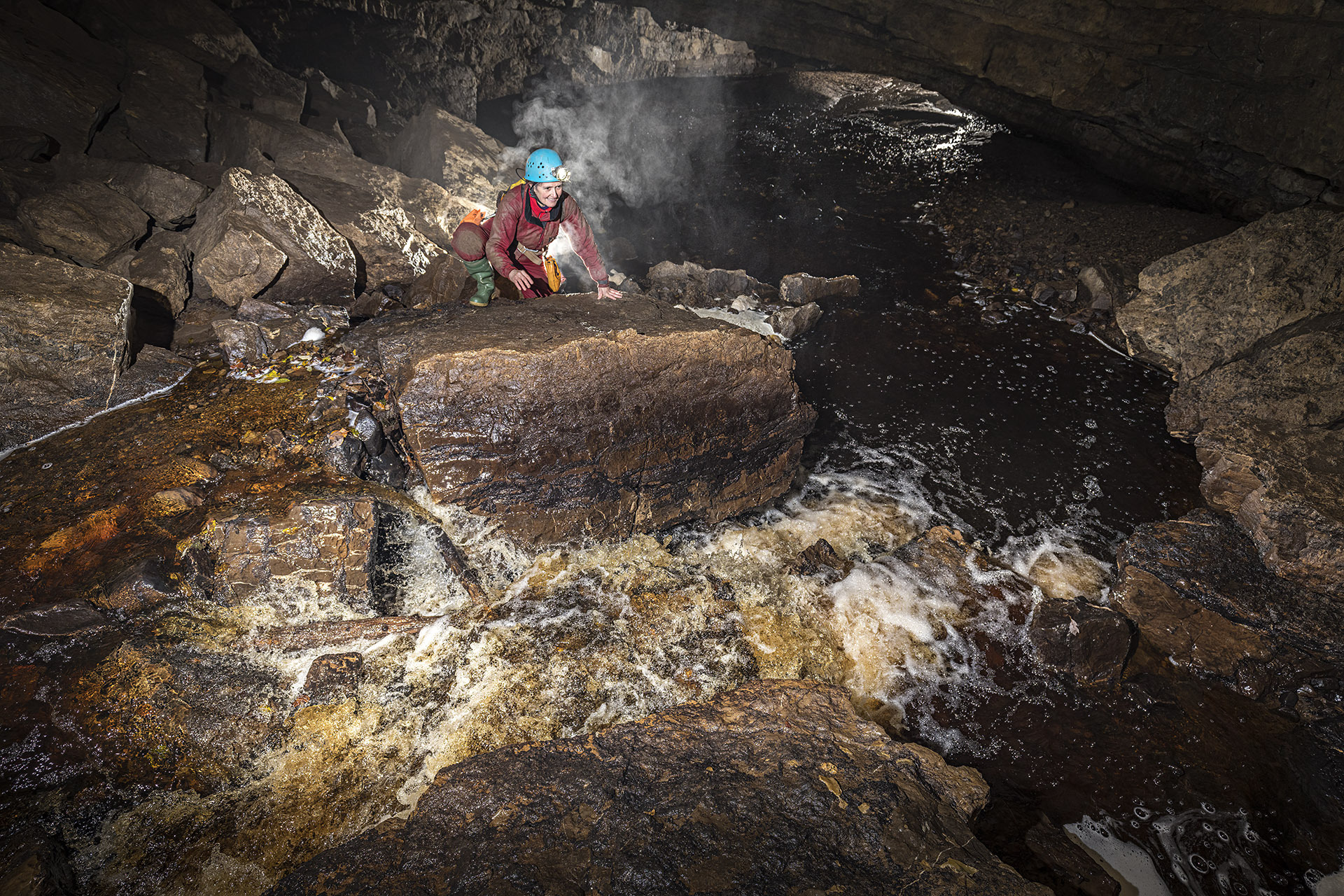 Judith Calford in Coolarken. Photo copyright Chris Howes. Judith Calford in Coolarken. Photo copyright Chris Howes.
|
|
MANY MUSINGS
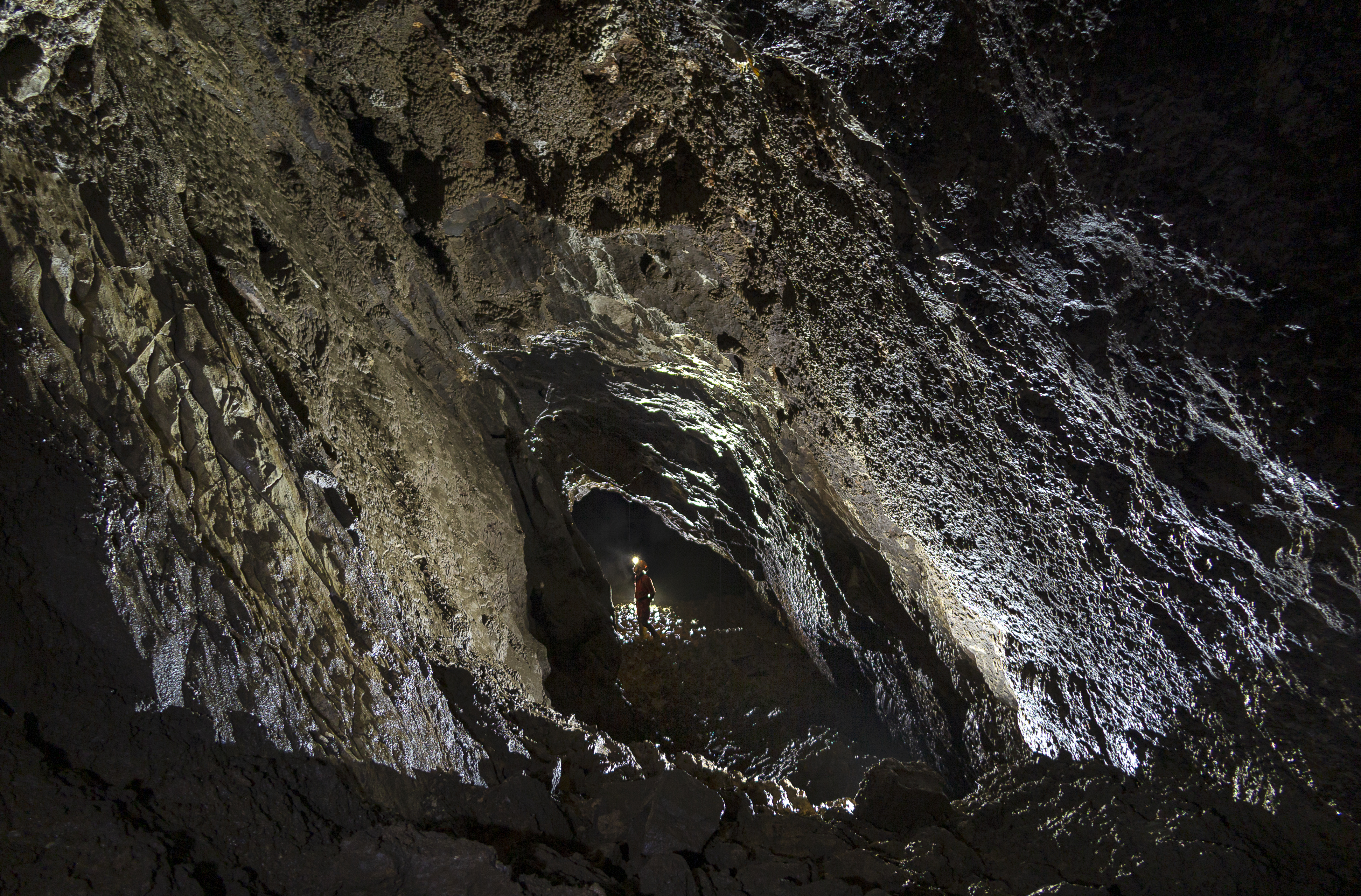
East Passage, Pen Park Hole. Photo copyright Steve Sharp and used with his kind permission.
Fiona Whitaker’s Pen Park Hole trip report in the last Newsletter has spurred a bit of debate, so here is UBSS thinking/talking about cave science.
Mike Simms commented: “I did read to the end, and always do. Some
spiffing stuff this month, especially about PPH. Hypogenic? Hmmm... I'm
not convinced - yet. Fluid inclusion analysis of the calcite crystals
will indicate temperature of deposition, but those in the Cromhall
Triassic cave suggested it was not geothermal and I suspect that a lot
of this calcite crystal crust is due to ponding and development of a
static phreas as the adjacent valleys filled with sediment through the
late Triassic (post Carnian Pluvial Episode). My U-Pb person might
be able to get a date from the calcite, although she struggled with the
Cromhall crystals and was unable to get a date from large crystals
lining some Triassic caves at Tidenham. Pb is no good for U-Pb dating
because it contains... too much lead.”
With Mike’s agreement, this was circulated to other interested parties.
Andy Farrant was the first to respond, saying: “My take on PPH is that
the overall morphology of the cave is very different to the Cromhall
caves, which are more typical of epigenic caves (and are infilled with
Triassic sediment). PPH is a very large isolated chamber, unlike any
epigenic caves in the region. That, plus the fact we have some galena in
with the calcite, and clear evidence of secondary dissolution, possibly
condensation corrosion, plus the location on a major fault suggests a
hypogenic origin. But a U-Pb date or fluid inclusion work would clinch
it…”
Graham chimed in: “As for PPH, it’s not just the mineralogy that make it
likely hypogenic, it’s the blind passages (several) in a tree-like
pattern, the deep rounded solution pockets (click on the image below for
a piece of video of a deep pocket just off the first chamber) and
patches of highly corroded patches (harder to find, but they do exist) ,
all diagnostic features according to Ford & Williams (AKA the Bible
…).
|
|
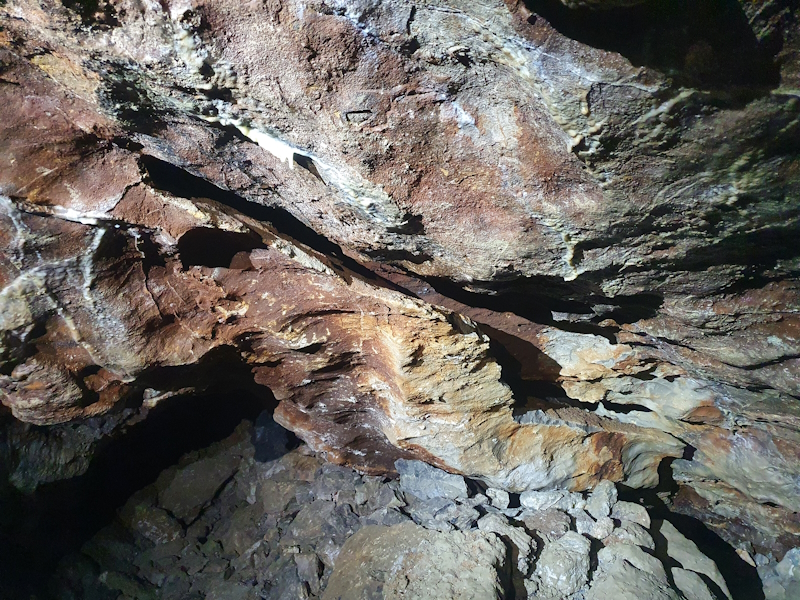
|
|
Click on the photo to view the video. Video taken by Linda Wilson with the assistance of Jan Walker.
|
|
Graham
continued: “What I won’t do is die in a ditch over the date. One of
Bristow’s important points about that is that the cave pre-dated certain
earth movements. He based this in large part on a calcite band with
an apparent fault running across it. However, on one of the
earliest trips in there after we re-opened it in 1993, Willie Stanton
and I traced that and demonstrated that it actually wasn’t a fault, more
an optical illusion.”
David Richards added: “I have a vague
recollection of scanning material from PPH for U and Pb conc. in a batch
of samples from the Bristol calcite collection in 1996. Chris Smith
might also have had a shot in 2014 at BGS. I'll try to find the
data and share.”
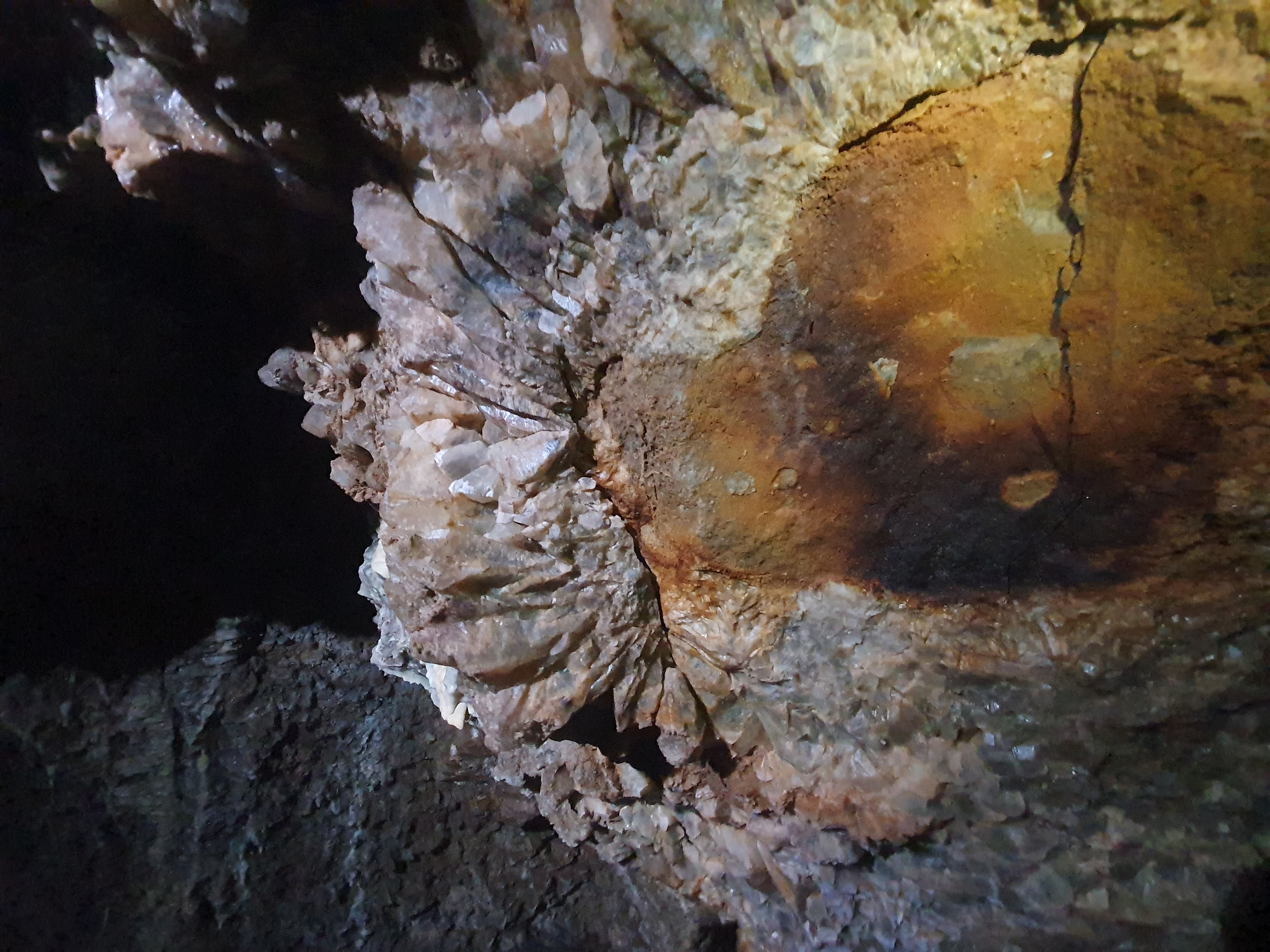
Broken calcite crust, near the head of the pitch. Photo by Linda Wilson.
Back to Fiona, where this conversation
started. and with regard to Mike’s comment that he suspects that a lot
of the calcite crystal crust is due to ponding and development of a
static phreas as the adjacent valleys filled with sediment through the
late Triassic: “From a water chemistry perspective we have to think what
could cause ponded waters to become supersaturated to drive
precipitation - they should equilibrate with host rock and sit and
chemically sulk. The volume of calcite crystal observed requires a
source of Ca (dissolution locally? at depth?), a flux to supply
sufficient pore volumes (a lot given the amount observed) and a drive to
shift waters from calcite equilibrium to supersaturation (change in
temp/pressure/dissolved gas composition/mixing). We also know that
(at least elsewhere) there is no clear zonation - these type of crystals
appear to be formed from a single water composition. Our work will
resolve whether this is also the case at PPH. All of these
requirements favour an active circulation and hydrothermal … A date
would be super useful I agree, though not sure it would be bomb proof
evidence of hypogene dissolution. And Pb concentrations I think were
problematic - can’t recall where I read this. Suggests someone has
already tried?”
Cathy Hollis from Manchester Uni added: “I
agree that U-Pb is a long shot but we are hoping we can give it another
try on our Derbyshire samples, pending some trace element analysis which
is in progress. We are also going to run clumped isotope analysis
for temperatures on the Derbyshire samples and could through in PPH….
May be more successful than fluid inclusions.”
Back to Graham: “Many years ago, Charlie Self gave a sample to (I think)
Simon Bottrill to do the fluid inclusion thing. Nothing ever came back
to him or me, it might be worth somebody chasing him up. You never know.
“As far as dating is concerned, I’m pretty sure that U-Pb would fail on
too much lead. I remember Charlie (again) clutching some nice galena
samples that he’d picked up somewhere just beyond the 1st
chamber. Funnily enough the other place locally that we came across
galena was in a fracture immediately beneath the GB blockhouse.”
So, that’s where the debate rests for the moment. We now need to get some more science done!
Thanks to Mike, Graham, Andy, Fiona, David and Cathy for contributing to the debate.
|
|
BADGER READ TO THE END, DID YOU?

Sorry, Megan, Bing AI couldn't manage a badger in aviator shades! This
was the best Bing images could manage. It couldn't spell Harry, either!
Thank you to everyone who clicked
on our link last month! Please keep the replies coming. It's great to
get some feedback, and as ever, there'll be a prize for the first
student to email us after getting to the end! Prizes can be collected in
the pub or at the Xmas dinner, if you're going. If not, we'll work
something out.
- Ta Da!!! [Graham Mullan] [Note: Nope, still not a student, but keep trying.]
- Hello, Batti! You are rather spiffing, as was the newsletter!
Great trip stories, and I’m really happy to see so many new cavers this
year! Some fascinating places, and Pen Park Hole will always have a
special place in my heart. It was, after all, my first cave – in
trainers, leggings, a wind-cheater jacket and a borrowed helmet!
[Jan Walker]
- Hello, Bat! And hello, freshers - sounds like the trips were
fun. Excellent reports and pix. I admit to being discombobulated and
clearly watched too much of the rugby World Cup, as I wondered why
Ireland coach Andy Farrell was going caving (sorry, Andy Farrant!) And
WHY did the caving model have the camera attached to his todger?
Enquiring minds and all that … [Sharon Wheeler and the blessed FT
Bear] (we can fawn if you need us to!)
- Ah, Goatchurch. The only cave in which I’ve personally had an
accident in almost half a century; beware the well-polished rocks. I
found myself chewing a stalagmite, spitting out bits of tooth while the
kids in the group I was leading fell about with laughter. [Dick
Willis]
- Hello Bat, nice to meet you! [Hans Friederich]
- I did read to the end, and always do. Some spiffing stuff this
month, especially about PPH. Hypogenic? Hmmm...I'm not convinced - yet.
Fluid inclusion analysis of the calcite crystals will indicate
temperature of deposition, but those in the Cromhall Triassic cave
suggested it was not geothermal and I suspect that a lot of this calcite
crystal crust is due to ponding and development of a static phreas as
the adjacent valleys filled with sediment through the late Triassic
(post Carnian Pluvial Episode). My U-Pb person might be able to
get a date from the calcite, although she struggled with the Cromhall
crystals and was unable to get a date from large crystals lining some
Triassic caves at Tidenham. Pb is no good for U-Pb dating because it
contains...too much lead. [Mike Simms]
- Miss the caving family so much! Sending lots of dark, cold wet affection from Denmark. [Guy Maalouf]
Of course I read to the end, Badger, you can count on me!
THE END
|
|
|
|